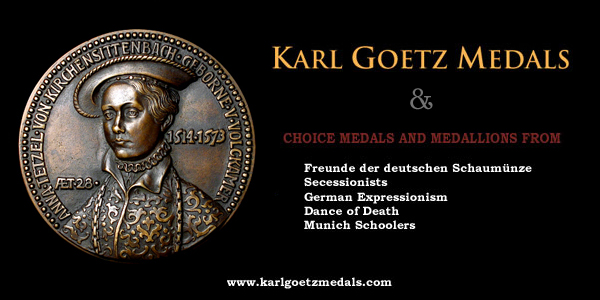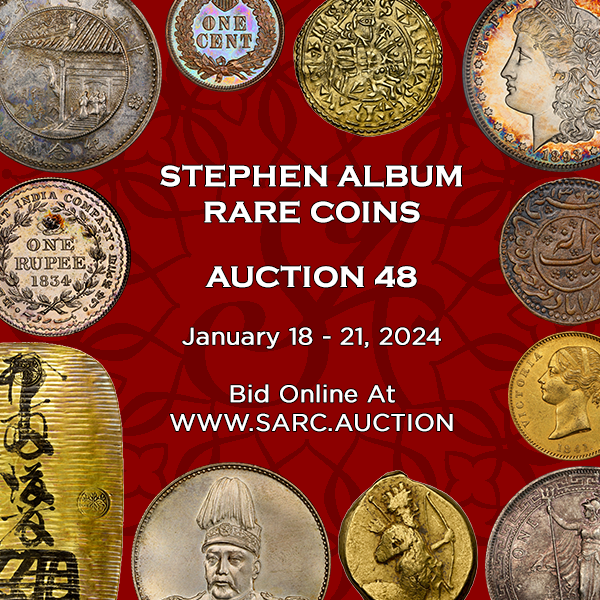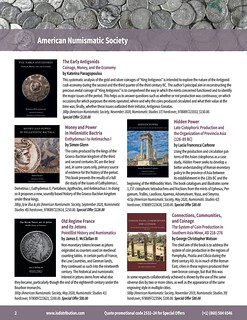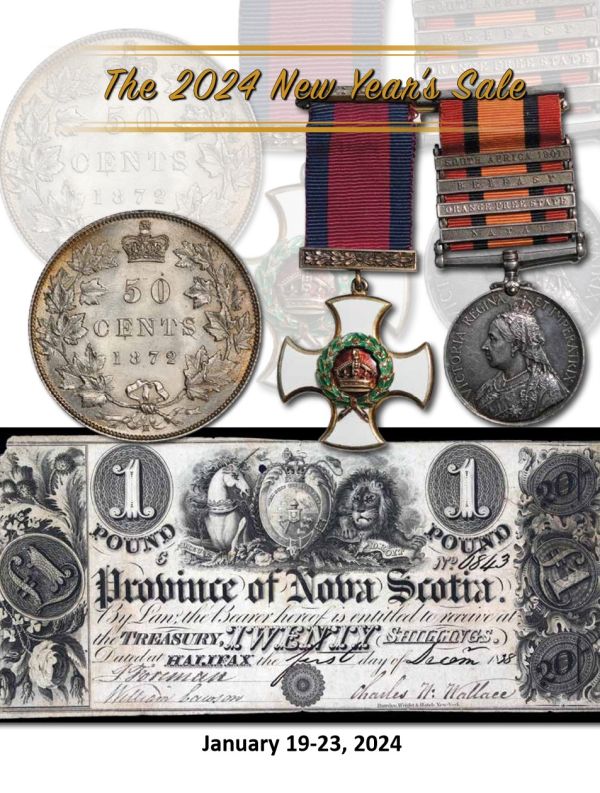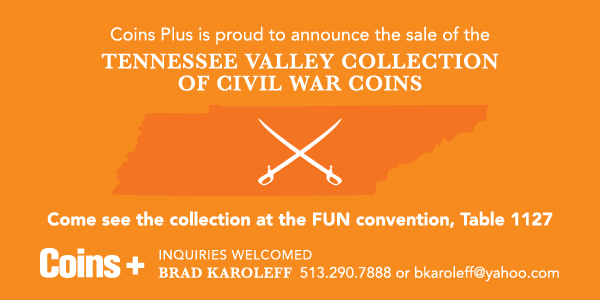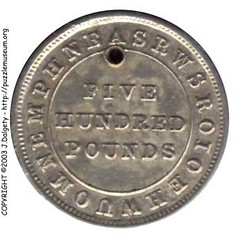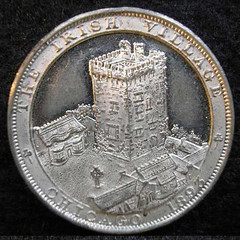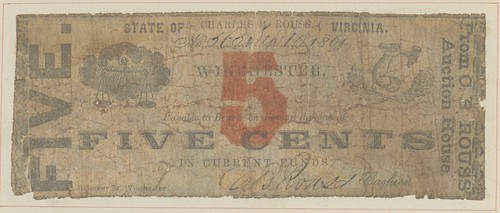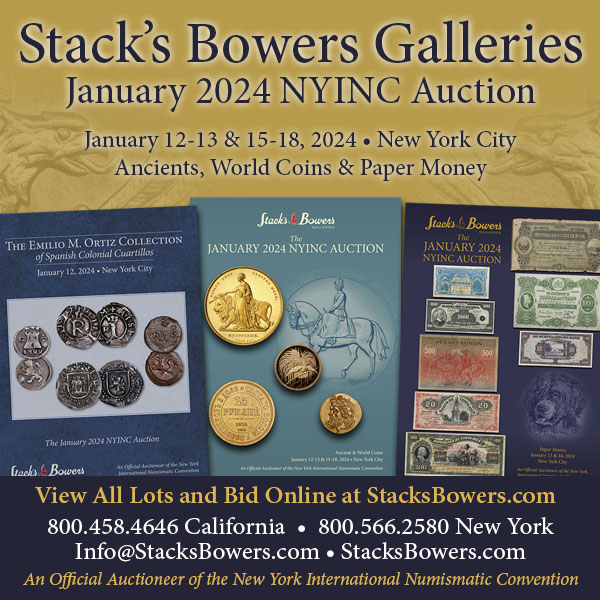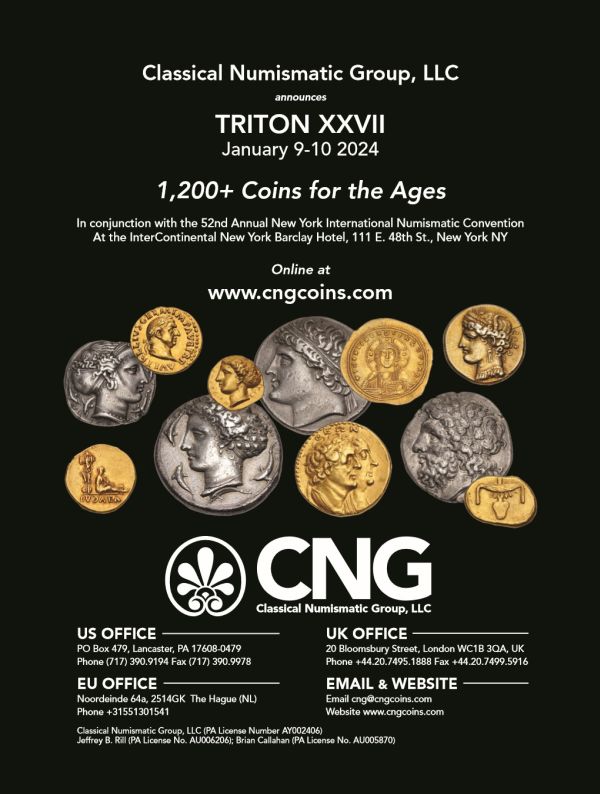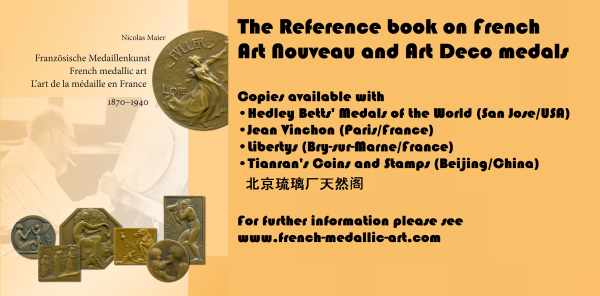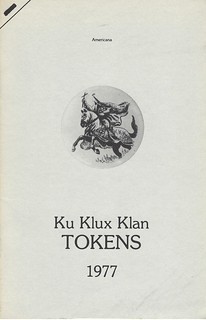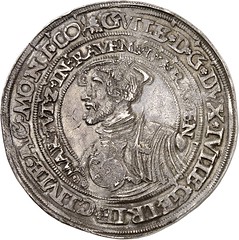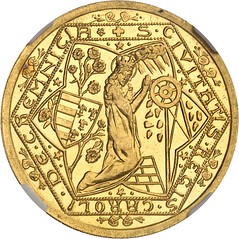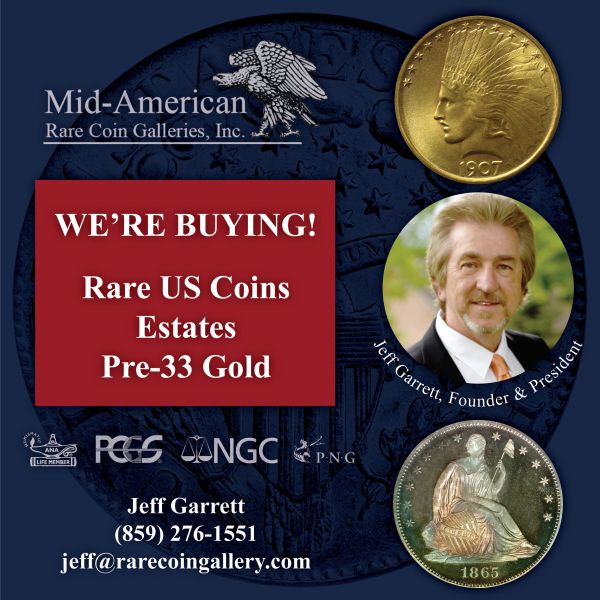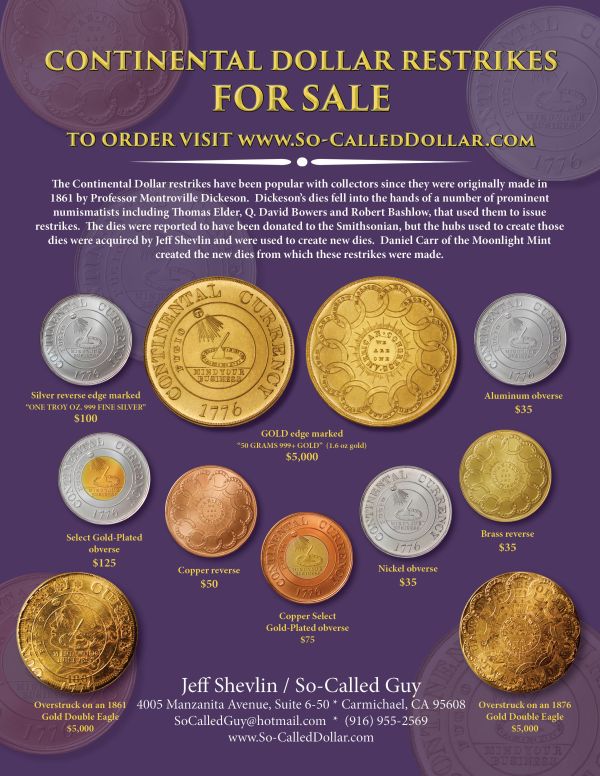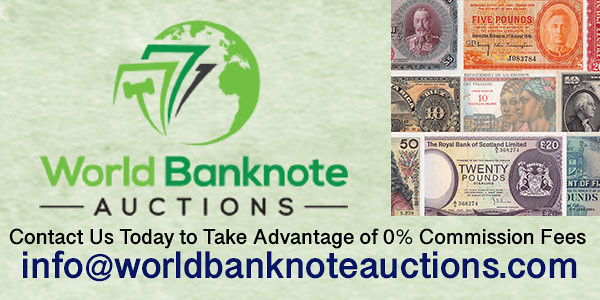
Visit our NBS Sponsors
About UsThe Numismatic Bibliomania Society is a non-profit association devoted to the study and enjoyment of numismatic literature. For more information please see our web site at coinbooks.org SubscriptionsThose wishing to become new E-Sylum subscribers (or wishing to Unsubscribe) can go to the following web page link MembershipThere is a membership application available on the web site Membership Application To join, print the application and return it with your check to the address printed on the application. Print/Digital membership is $40 to addresses in the U.S., and $60 elsewhere. A digital-only membership is available for $25. For those without web access, write to: Jeff Dickerson, Treasurer AsylumFor Asylum mailing address changes and other membership questions, contact Jeff at this email address: treasurer@coinbooks.org SubmissionsTo submit items for publication in The E-Sylum, write to the Editor at this address: whomren@gmail.com BUY THE BOOK BEFORE THE COIN |
- WAYNE'S WORDS: THE E-SYLUM JANUARY 7, 2024
- KOLBE & FANNING BUY OR BID SALE NUMBER 23
- NEW BOOK: SPECIAL SERIAL NUMBERED BANKNOTES
- NEW BOOK: MONEY BOXES
- ANS PUBLICATION CATALOG PUBLISHED
- HAPPY NEW YEAR NUMISMATIC TOKENS
- VIDEO: LARRY WILSON INTERVIEW
- MORE ON JOHN BURNHAM
- UNSOLVED NUMISMATIC PUZZLES FROM DUBLIN
- NOTES FROM E-SYLUM READERS: JANUARY 7, 2024
- BLIND COIN COLLECTOR UPDATE
- THE VERMONT POUND THEORY
- DEAL RESCUES STANLEY GIBBONS AND BALDWIN'S
- VOCABULARY TERM: OXIDATION
- UPDATE: KKK TOKENS AUTHOR DALE BIRDSELL
- TOM CALDWELL INTERVIEW, PART TWO
- TIBET MUSEUM'S NUMISMATIC EXHIBIT
- KüNKER SALE 400 HIGHLIGHTS
- NUMISMATIC NUGGETS: JANUARY 7, 2024
- THE COIN THAT SHOULDN'T EXIST
- LINCOLN CENT MULED WITH A ROOSEVELT DIME
- AUSTRALIA MINTS WORLD'S 1ST COIN IN 2024
- HARRIET TUBMAN COMMEMORATIVE COINS
- TAMPA'S BREADCOIN TOKENS
- THE INIMITABLE NOTE COMPETITION
- THE JAMES W. FERRY TRAVEL NOTE
- CRAFTY COUNTERFEIT DISPLAY, PART ONE
- LOOSE CHANGE: JANUARY 7, 2024
- FEATURED WEBSITE: COIN OF NOTE
Content presented in The E-Sylum is not necessarily researched or independently fact-checked, and views expressed do not necessarily represent those of the Numismatic Bibliomania Society.
WAYNE'S WORDS: THE E-SYLUM JANUARY 7, 2024
 New subscribers this week include:
Jackie Wesche-Thobaben and Ryan Spak
of the Western Pennsylvania Numismatic Society, courtesy Ed Krivoniak;
Emma Hulme of Sovereign Rarities Ltd, courtesy Steve Hill;
Welcome aboard! We now have 7,646 subscribers.
New subscribers this week include:
Jackie Wesche-Thobaben and Ryan Spak
of the Western Pennsylvania Numismatic Society, courtesy Ed Krivoniak;
Emma Hulme of Sovereign Rarities Ltd, courtesy Steve Hill;
Welcome aboard! We now have 7,646 subscribers.
Thank you for reading The E-Sylum. If you enjoy it, please send me the email addresses of friends you think may enjoy it as well and I'll send them a subscription. Contact me at whomren@gmail.com anytime regarding your subscription, or questions, comments or suggestions about our content.
This week we open with a numismatic literature sale, two new books, updates from the Newman Numismatic Portal, notes from readers, and more.
Other topics this week include unsolved numismatic puzzles, the "Vermont Pound", Baldwin's, Dale Birdsell, Tom Caldwell, the first coin minted in 2024, the Tubman commemoratives, Breadcoins, and the Inimitable Note competition.
To learn more about special serial numbers, coin banks, Toltec scraper money, the South Carolina SPCA medal, gradeflation, the 1819 George Cruikshank Bank Restriction note, the 1820 George III Pattern 5 pounds, the Society of Music Friends medal, and the coins that shouldn't exist, read on. Have a great week, everyone!
Wayne Homren
Editor, The E-Sylum
KOLBE & FANNING BUY OR BID SALE NUMBER 23
Numismatic Booksellers Kolbe & Fanning submitted this announcement of their 23rd "Buy or Bid Sale" which closes on January 16, 2024. Good luck, everyone! -Editor
 Kolbe & Fanning Numismatic Booksellers have announced our latest
Kolbe & Fanning Numismatic Booksellers have announced our latest Buy or Bid Sale,
which begins now and will close on Tuesday, January 16, 2024. With hundreds of new additions, the sale focuses on modestly priced books, giving collectors an opportunity to add to their libraries at minimal cost.
The sale includes over 1200 works on ancient, medieval and modern coins, as well as general works, periodicals and sale catalogues. Buy
prices have been kept low to promote sales. To further encourage participation, the firm is offering free domestic shipping to bidders spending at least $300; there is also no packing and processing fee for this sale. Again, please read the Terms of Sale before participating.
As the name of the sale suggests, customers may bid on items they wish to acquire or buy them outright at the published price. The Terms of Sale will give full instructions on how to participate: please read it carefully.
There is no printed catalogue. The PDF catalogue is available now for downloading from the Kolbe & Fanning website at numislit.com. Please send all bids to orders@numislit.com or use the bid sheet included at the end of the PDF catalogue.
To read the complete catalog, see:
https://numislit.cdn.bibliopolis.com/images/upload/kolbefanningbob23.pdf?auto=webp
THE BOOK BAZARRE
NEW BOOK: SPECIAL SERIAL NUMBERED BANKNOTES
With permission we're republishing this article from the January 2024 issue of The Mint Master from the Utah Numismatic Society by Editor/Publisher Doug Nyholm, about a new book on a specialized paper money topic by Mike Abramson. Thanks! -Editor
 This new book by Mike Abramson just arrived a
few days before Christmas to my mailbox. It may
not be for everyone but for me it is a significant
work on a subject that has never been written about
before except for in auction catalogues where these
notes have appeared.
This new book by Mike Abramson just arrived a
few days before Christmas to my mailbox. It may
not be for everyone but for me it is a significant
work on a subject that has never been written about
before except for in auction catalogues where these
notes have appeared.
Mike stated that all of the notes illustrated in this book are ones that he has owned, handled, brokered, or sold except for just 5 of them. The combined value of these notes exceeds $40 million dollars.
So what is a serial number? Plenty! If you are lucky enough to acquire one which is almost impossible, even looking for a low s/n amongst all the notes that pass through your hands is extremely unlikely. I look through all the notes in my wallet and from circulation have never found one with more than 4 leading zeros. Or to be exact one with a serial number around 2000. Other notes that may occasionally be found are radars or repeaters such as 23455234 or 45604560 but even these are rare.
Once while on a buying trip a customer came in with a $10 S/n 77777777 which his wife received from their bank. I was amazed and immediately purchased it. Generally these notes are acquired by people who work at facilities that handle vast sums of banknotes and keep their eyes open but the exact nature of their operations are a subject for an extensive article.
This book illustrates not only serial numbers of both older large size notes but current small size notes. It shows collections of special groups, repeaters, ladders and just about everything that a serial number can offer. Also tables and statistics are included. There are also images of changeover pairs and 9 digit serial numbers.
It is truly a fascinating book with high quality images, statistics and information not available elsewhere. It consists of 270 pages in 8 1/2 x 11 format, full color, and 500+ pictures on quality gloss paper. It is available for $59.95 postpaid directly from the author as follows:
Mike Abramson, 3719 N. Ridge Rd., Duluth MN 55804-1480
Or by contacting him at macurrency@aol.com 218-310-0090
This is a great addition to my library and I haven't been able to stop drooling over the pictures.
I must admit I don't check serial numbers very often, so it's no wonder I'd never found a really good one. And I had a chance this week after the New Year's Eve party at our house where I won a friendly dice game played with one dollar bills. I won one of the final pots, walking away with 45 bucks. I spent them in small batches throughout the week, each time explaining, "I'm a Chippendale dancer..." -Editor
NEW BOOK: MONEY BOXES
From Budapest Dave Hirt writes:
 "My numismatic friend Balazs
gave me three new books for Christmas. I want to report on one of them. The text is in two languages, Hungarian and English. The English title is Coin Boxes (small saving banks). The Hungarian title is PERSELYEK.
It is written by Andras Szlanka, the curator of the OTP Bank' s History of Finance Collection.
"My numismatic friend Balazs
gave me three new books for Christmas. I want to report on one of them. The text is in two languages, Hungarian and English. The English title is Coin Boxes (small saving banks). The Hungarian title is PERSELYEK.
It is written by Andras Szlanka, the curator of the OTP Bank' s History of Finance Collection.
"The book has over 300 pages, each one having an illustration of a bank. I had not given any thought to the connection of these banks to coin collecting. I believe that many numismatists, including myself, got their start saving coins, when getting a present of a small bank, perhaps with a few coins to start their savings...
"There are amazing and artistic differences, starting with silver banks from the 19th century, brass, copper, medal, ceramic, cardboard, paper, etc. There is a whole section on piggy banks. The illustrations are quite interesting."
Thank you. With Dave's help I was able to find a page for the book online. Here's a lightly edited Google translation. -Editor
MONEY BOXES - A SELECTION FROM THE HISTORY OF FINANCE COLLECTION OF OTP BANK
EDITORS
András Szlanka
László Lekes
PROOFREADER
Dr. Lajos Pallos
PHOTOGRAPHERS
László Lekes
András Oravecz
Publisher: Green Print-GPR Kft.
Release year: 2011
Binding type: Laced hard paper binding
Pages: 335 pages
Language: Hungarian
Size: 20 cm x 29 cm
ISBN: 978-963-214-649-2
Comment: Richly illustrated with color photos.
For more information, or to order, see:
MONEY BOXES - VÁLOGATÁS AZ OTP BANK PÉNZÜGYTÖRTÉNETI GYUJTEMÉNY ANYAGÁBÓL/A SELECTION FROM THE HISTORY OF FINANCE COLLECTION OF OTP BANK
(https://www.antikvarium.hu/konyv/szlanka-andras-perselyek-1090671-0)
ANS PUBLICATION CATALOG PUBLISHED
In an email to members this week, the American Numismatic Society announced a new distribution partnership for its publications. -Editor
The American Numismatic Society proudly partners with ISD for the distribution of our publications to customers in the United States. ISD has just released a special catalogue of new, recent, and backlist numismatic titles that they distribute, highlighting those from the ANS and from other publishers of numismatic literature.
Don't forget—ANS members in the US receive a 30% discount on ANS publications from ISD using [a membership] code
To access the complete catalog, see:
https://www.isdistribution.com/CatalogLeafletRender.aspx?lId=223
HAPPY NEW YEAR NUMISMATIC TOKENS
Newman Numismatic Portal Project Coordinator Len Augsburger provided this report. Happy New Year! -Editor
 HAPPY NEW YEAR NUMISMATIC TOKENS
HAPPY NEW YEAR NUMISMATIC TOKENS
One of the most frequently accessed references on Newman Portal is Pete Smith's Personal Tokens and Medals of American Numismatists, published in 2020. The popularity of certain documents on the Internet is sometimes somewhat of a mystery, but we've noticed that works that refer to many individual persons tend to run hot.
This volume has been accessed 8,386 times, indicating daily use by multiple people.
HAPPY NEW YEAR is a common theme on numismatic tokens. Indeed, of the approximately 8,000 tokens, medals and woods cataloged in Pete Smith's work, nearly 600 feature the inscription HAPPY NEW YEAR. Issuing dealers include Dottie Dow, Doug Fairbanks, Al & Sally Kirka, and a host of others.
Image from The Token Catalog:
San Jose, California (Santa Clara County), U.S.A. TokenCatalog #140194
(https://tokencatalog.com/)
Link to Pete Smith books on Newman Portal:
https://nnp.wustl.edu/library/booksbyauthor/1811
VIDEO: LARRY WILSON INTERVIEW
The David Lisot Video Library on the Newman Numismatic Portal can be found at:
https://nnp.wustl.edu/library/multimediadetail/522852
We highlight one of his videos each week in The E-Sylum. Here's one from 1985 with Colorado collector Larry Wilson. -Editor
Collector Larry Wilson talks Toltec scraper money, Aztec copper hoe money, Indian Peace Medals, guitars and more!
The segment begins around the 11:25 mark, following an odd musical cartoon public service commercial from the U.S.D.A and H.H.S. about salt and sodium. -Editor
To watch the complete video, see:
Collector Talk: Larry Wilson
(https://nnp.wustl.edu/library/book/584159)
MORE ON JOHN BURNHAM
Numismatic bookseller and NBS co-founder George Kolbe submitted these notes on the late John Burnham. Thank you. -Editor
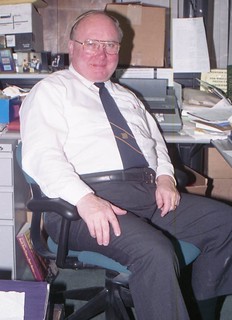 As previously attested in the E-Sylum, John Burnham loved books, and that extended to the numismatic variety. We likely met at a New York coin convention in the early 1980s. I often stayed at the Salisbury Hotel, adjacent to Stack's retail store on 57th Street. Its glory a bit faded, the Salisbury nonetheless had a certain charm, considerably enhanced by reasonable room rates.
As previously attested in the E-Sylum, John Burnham loved books, and that extended to the numismatic variety. We likely met at a New York coin convention in the early 1980s. I often stayed at the Salisbury Hotel, adjacent to Stack's retail store on 57th Street. Its glory a bit faded, the Salisbury nonetheless had a certain charm, considerably enhanced by reasonable room rates.
John and I hit it off almost immediately – despite our different backgrounds, we were simpático. A consultant to Stack's Coin Galleries, John regularly spent a night or two each week at the Salisbury. Early on, I remember securing a bottle of Johnny Walker Red and enjoying an evening with John at the Salisbury, bravely solving the world's political and cultural problems. Other memories abound.
In the mid 90s, I travelled to Orlando, Florida to acquire the numismatic library on ancient coins formed by Frederick Knobloch. John was there for the coins. The trip from the airport in the car of a female family member was a little unusual. A handgun graced the center console, which, she assured me, was locked and loaded, and always accompanied her. At the house, a shotgun resided behind the entry door. After successfully conducting our business deals, John and I spent another delightful evening, albeit this time in a dismal motel room, permeated with an inescapable eau de mildew.
One year, John invited me to visit him at Yale, where he was the curator of the university's numismatic collection. Down the hall from his office was a room housing a portion of Yale's numismatic library. On one wall was a uniformly bound set of The Numismatist, including original issues of the first six volumes. Yale's holding of this numismatic rara avis was little known at the time and I was duly impressed. There were other delicacies, including rare works on orders and decorations, and a tall stack of early twentieth century U.S. coin catalogues with photographic plates. Later, we dined on campus. It was a wonderful day.
In 2007, I spent several days in New York City, partly devoted to packing a wonderful library of rare and classic works on military orders and decorations. Many were in large format, featuring magnificent chromo-lithographic illustrations and deluxe bindings. Located in a desirable high rise near Tavern on the Green, the flat had long been occupied by a recently deceased colleague of John's. I packed some fifty large cartons of books which were to be sent to me for sale forthwith. To John's chagrin, and mine as well, legal difficulties arose, and the library apparently remains unpacked to this day. Through John's good offices, and that of the executor of the estate, I was compensated for my expenses and time.
In more recent years, John and I occasionally conversed via telephone. We sometimes conspired to meet at a convention or an auction, Alas, these plans never materialized. I am the poorer for it.
To read the complete article, see:
OHN P. BURNHAM (1940-2023)
(https://www.coinbooks.org/v26/esylum_v26n53a04.html)
UNSOLVED NUMISMATIC PUZZLES FROM DUBLIN
Gawain O'Connor writes:
"Perhaps your item about puzzles is not totally non-numismatic after all. The Hordern-Dalgety Collection of puzzles still has a website at https://www.puzzlemuseum.com/
"A couple items that I have wondered about for years are on their unsolved puzzles page: https://www.puzzlemuseum.com/month/picm02/200206dublin.htm
"I wonder if anyone has ever solved these. Perhaps modern deciphering techniques can help...
"Johnson was in business a hundred years ago, but I haven't found their successors, or anyone who might know something about the solution."
Thank you! I hadn't seen these before. Anyone want to try their hand at these? -Editor
This very small (16mm diameter) silver token probably dates from the late 19th Century. We guess that a prize of £500 was offered for deciphering the message:-
"ASRWSROIOEHWUOMNEMPHNE"
Five hundred pounds would have been a very large sum. We have not been able to decipher the message so will give a small prize, definitely not £500, to the first person to tell us the answer.
Johnson of Dublin also made this larger (27mm diameter x 2.5 mm thick) medal for the Irish Village at the Columbian Exposition in 1893.
We will give another small prize, definitely not $1000, for the first person to decipher this:-
"AETENVMTEFISIRISTSEALI"
To read a lot descriptions from current and earlier sales, see:
Roma Numismatics Ltd. > E-Sale 112
(https://www.coinarchives.com/w/lotviewer.php?LotID=6500005&AucID=7541&Lot=1559&Val=0590f3e8acab53eb1617f0e2e03c0bc6)
Irish Tokens, Co. Dublin, Dublin, Johnson, Jeweller, advertising tickets (2)
(https://www.numisbids.com/n.php?p=lot&sid=2839&lot=219)
Irish token - Johnson jewellers £500 - pierced silver Dublin Ireland 16.2mm
(https://www.ebay.co.uk/itm/354754083499)
All of the £500 pieces are holed - why?
Secret codes are also in the mainstream news - here's a Washington Post article about a code found hidden in a late 19th-century woman's dress. -Editor
The mystery was sparked when archaeologist and antique fashion collector Sara Rivers Cofield purchased an 1880s-era silk gown at a Maine antique mall in 2013. The bronze-colored dress held a secret: A hidden pocket beneath the bustle contained crumpled, handwritten notes covered with place names, seemingly random words and numbers.
Suspecting the notes were in code, Cofield posted the puzzle online, where it intrigued — and stymied — cryptographers.
Eventually, the dress earned a place on code aficionados' lists of ongoing mysteries — until Wayne Chan, an analyst with the University of Manitoba's Center for Earth Observation Science, got a hold of it.
To read the complete article, see:
An antique dress hid coded messages that have finally been unlocked
(An antique dress hid coded messages that have finally been unlocked)
To read the earlier E-Sylum article, see:
PUZZLE PURISTS DECAMP TO A CASTLE
(https://www.coinbooks.org/v26/esylum_v26n53a26.html)
NOTES FROM E-SYLUM READERS: JANUARY 7, 2024
Charles Broadway Rouss of Winchester, VA
Eric Schena writes:
"That is a really neat book of notes; the one note from Winchester was issued by Charles Broadway Rouss who ran an auction house on Loudoun St. He later left and made his fortune in New York but bequeathed a considerable amount of money back to Winchester. City Hall is named after him, as is one of the bigger fire departments, plus numerous other things. Those are quite rare (the Jones-Littlefield catalog carries it as an R-7) and I have been looking for one for many years. Really a neat item!"
Agreed - I knew Eric would appreciate this note - he lives in Winchester and has collected Virginia scrip notes for quite a while. Great piece. -Editor
To read the earlier E-Sylum article, see:
SOUTHERN STATES BANKNOTE ALBUM
(https://www.coinbooks.org/v26/esylum_v26n53a24.html)
On Morgan Bulkeley
Pete Smith writes:
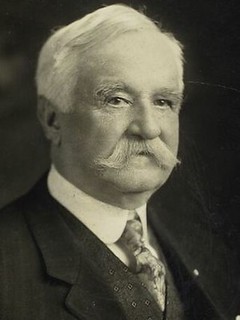 "I was initially confused by the statement about Bulkeley that he was one
"I was initially confused by the statement about Bulkeley that he was one who had
contributed just under 20,000 items to the American Numismatic Society.
I came to
realize that getting on the list would only have required the contribution of one item.
Bulkeley was not a member of the ANA. His name does not appear on membership
cards for the ANS. Why would someone who is not a member contribute?
The ANS has a couple of Bulkeley medals in the collection that do not make
reference to a donor or an accession dale. Perhaps one of these was donated by Bulkeley."
Gary Greenbaum writes:
"Possibly I was ambiguous. I meant to convey what Pete said, that he was among the ninety-odd contributors who together contributed some 20,000 items. Sorry for the misunderstanding."
Agreed. Bulkeley may not have been a major donor. Thanks also to Jim Haas for forwarding some biographical information and newspaper articles. -Editor
To read the earlier E-Sylum article, see:
NOTES FROM E-SYLUM READERS: DECEMBER 31, 2023 : Morgan Bulkeley Information Sought
(https://www.coinbooks.org/v26/esylum_v26n53a10.html)
Query: Humane Society 1850 Medal
Dave Baldwin writes:
"Trying to find something out about a medal and having no luck so I thought your readers may have a clue. It is the South Carolina SPCA medal, specifically the "Humane Society 1850" die.
"And as always thank you for the great work on the newsletter. Look forward to it arriving every week."
Interesting medal that I've never seen before. Is anyone familiar with this? Any research information you can dig up? -Editor
To read the complete page on Dave's Lovett website, see:
George H Lovett Gallery Part 1 Miscellaneous Award Medals
(http://ghlovett.blogspot.com/p/miscellaneous.html)
Decimalization of the British Monetary System
"The British Numismatic Society meeting at NYINC will take place in the Morgan Suite at the InterContinental New York Barclay, on E 48th Street, on Friday January 12th, at 4 PM.
"I'm very pleased to say that our speaker will be Dr Jesse Kraft, the Resolute Americana Assistant Curator at the American Numismatic Society, where he oversees the collection of coins, tokens, medals, and paper currency of the Western hemisphere. His talk is entitled ‘An incalculable advantage': Nineteenth-century attempts at the decimalization of the British monetary system."
Here's the summary of the talk. -Editor
Over a century before ‘Decimal Day' the British government weighed the pros and cons of a decimalized currency. First proposed in 1824 and continuing through the century, Parliament debated the issue, organized commissions to research its potential, and published long studies into the matter. Conclusions were split, with some noting ‘an incalculable advantage' of the system, and others finding there to be ‘few merits' in decimalization. As a result, the British continued to use the duo-decimalized pound, shilling and pence system until 1971.
For more information on the show, see:
https://nyinc.info/
Money in 17th-century New Netherland
John Mutch passed along notice of this free online lecture on currency used by early North American settlers. Thank you! -Editor
Grain and tobacco, wampum/sewan, and beaver/drielings: making sense of money in seventeenth-century New Netherland and North America
 Program Description: The Hudson Area Library in collaboration with the Jacob Leisler Institute for the Study of Early New York History hosts a talk by Simon Middleton, PhD. and Associate Professor of History at William and Mary, about the diverse types of currency used by early North American settlers.
Program Description: The Hudson Area Library in collaboration with the Jacob Leisler Institute for the Study of Early New York History hosts a talk by Simon Middleton, PhD. and Associate Professor of History at William and Mary, about the diverse types of currency used by early North American settlers.
Middleton's talk will offer some thoughts on what we should make of the variety of coins and commodities used by settlers–everything from coins, grain, tobacco, wampum, and beaver pelts. Historians have long puzzled over the development of these diverse currencies, which the colonists gathered together in conventions referred to as "current money" or money of "this place."
Date/Time: Thursday, January 25, 6-7:30pm
Location: The event will be held virtually via Zoom.
For more information, or to register, see:
Grain and tobacco, wampum/sewan, and beaver/drielings: making sense of money in seventeenth-century New Netherland and North America
(https://historyroom.hudsonarealibrary.org/history-room-programs)
BLIND COIN COLLECTOR UPDATE
Tom Babinszki publishes the Blind Coin Collector blog. Last week he reviewed accessible coin exhibits at the Bank of Canada Museum. This week he submitted these notes on his recent numismatic adventures and a new publication he's developing. Thanks! -Editor
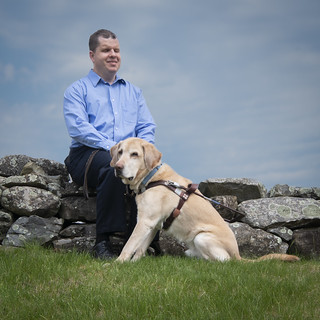 In August I spoke at the LEAD conference
about making coin exhibits accessible. I honestly didn't know who would benefit from it, but I thought if nothing else, it could be interesting. To my surprise, four organizations reached out for help with their accessible exhibits related to coins, money or numismatics.
In August I spoke at the LEAD conference
about making coin exhibits accessible. I honestly didn't know who would benefit from it, but I thought if nothing else, it could be interesting. To my surprise, four organizations reached out for help with their accessible exhibits related to coins, money or numismatics.
In October I was invited to the Smithsonian to review their Really Big Money educational program for kids. They had done a great job making it accessible.
I also visited the Bank of Canada museum, which you may know as the Currency Museum, which I visited a few years ago. They asked me to repeat my conference presentation, review their tactile exhibits, and we discussed tactile currency.
While in Canada, I have heard about the Canadian Numismatic Resources. In a way it is similar to the Newman Numismatic Portal, except much smaller in volume, and as I understand there is only very little overlap. So, in case you haven't heard about it yet, I would highly recommend it.
 And while talking about resources, I would like to bring a new blog to your attention, called
Coin of Note, by my good friend, Quentin, he is not using his last name publicly. He just started the blog this year, but already has a hundred posts. He has a much more diverse interest than mine, and you will find him write about all kinds of numismatic objects, I certainly learned a lot from him.
And while talking about resources, I would like to bring a new blog to your attention, called
Coin of Note, by my good friend, Quentin, he is not using his last name publicly. He just started the blog this year, but already has a hundred posts. He has a much more diverse interest than mine, and you will find him write about all kinds of numismatic objects, I certainly learned a lot from him.
The big thing this year was the development of artificial intelligence. I have used it in many different ways, particularly to make travel and collecting more accessible, but it just wasn't there where I could confidently write about it. However, with the release of new apps and the increased accuracy, though it still has issues, it is at a point where it is very usable. I wrote about how to use AI to recognize coins for blind people. At the moment, it is a completely different story for sighted people, there are some major developments going on, but the use cases for both groups are entirely different. For me, what is out there right now, is a game changer, and it is expected to improve further. I will keep you posted, because at this point, it is about new products as much as innovative use of existing ones.
At last, I would like to tell you about a new resource I'm putting together. As I admitted in my last newsletter, I was trying to write a book for ten years, in which there are ideas for two books, but content for none. I found that I was mostly writing for the desk drawer (ok, hard drive, no, cloud account). But it just doesn't make much sense to me. I'd rather put out good but incomplete information than nothing at all.
So, while I'm preparing my materials, I created a list of tactile currencies, and described the tactile marks. This is primarily for blind people who want to travel to countries which have tactile currencies, and the rest of my research is coming soon, but since this is information that is practically not available online, I thought I'd start with this. Even many national banks don't publish this information, so I have to email them individually, hoping that I will get a response. The other approach is to look at the individual bank notes, but it doesn't always feel like what it looks like. So, often, for lack of better, I order low denomination banknotes so I can verify the tactile features.
Anyway, the resource is here, so far with 11 countries, it is a work in progress. I have evidence of over forty countries which have tactile currencies, but I'm still gathering information. As I am adding more to the list, I will also add this information to the Numista catalog.
Links:
Tactile coin exhibits
(https://blindcoincollector.com/2023/09/27/tactile-coin-exhibits/)
Really BIG Money at the Smithsonian
(https://blindcoincollector.com/2023/11/08/really-big-money-at-the-smithsonian/)
The Bank of Canada Museum
(https://blindcoincollector.com/2023/12/15/the-bank-of-canada-museum/)
Canadian Numismatic Resources
(https://cnr-rnc.ca/)
Coin of Note
(https://coinofnote.com/)
Recognizing coins with artificial intelligence
(https://blindcoincollector.com/2023/12/13/recognizing-coins-with-artificial-intelligence/)
Tactile marks on currencies
(https://blindcoincollector.com/2023/12/28/tactile-marks-on-currencies/)
To read the earlier E-Sylum article, see:
REVIEW: BANK OF CANADA MUSEUM
(https://www.coinbooks.org/v26/club_nbs_esylum_v26n53.html)
THE VERMONT POUND THEORY
Website visitor David Carbino writes:
"The pound is the name of an international coin. The pound was a coin used for exchange in different money systems that held value. Vermont soldiers were paid in platinum according to multiple historic references books from VT, Massachusetts, the Smithsonian archives etc.
"The Morris unit was too large for normal business transactions according to George Washington who was a general in the American revolutionary war. John Hanson was the first president of the Continental Congress at the time when VT made its military payments for three years of fighting the British.
 "Coinage was created from european designs to manufacture the first american coinage.A coinage committee was created for that purpose. A U.S. colonel described a Russian platinum coin that was given to American officers during the war when he donated his officer pay to the Smithsonian to create the coin collection. Under donors and donations the Smithsonian and the Chicago Coin Club 1841. National Institute.
"Coinage was created from european designs to manufacture the first american coinage.A coinage committee was created for that purpose. A U.S. colonel described a Russian platinum coin that was given to American officers during the war when he donated his officer pay to the Smithsonian to create the coin collection. Under donors and donations the Smithsonian and the Chicago Coin Club 1841. National Institute.
"A ten thousand dollar transaction in precious metal was valued at 14,400,000 dollars because of a 1440% inflation rate on precious metals. A Spanish silver dollar was the federal unit valued at 1440 continental paper dollars. VT was backed by France, Russia, Spain, Holland as an independent royal colony. VT won the first three battles of the war when George Washington was losing to the British.
"The coin is described in Conant's Vermont 1915. It is also described in Morse's Geography 1804 Boston Massachusetts. A 12 ounce coin with decimal system which was replaced. A federal unit was in platinum and given to the soldiers by the records of the state. I can explain the system of math which includes joes and half joes to read it.
"I know it looks like a Russian medal and I have heard it before. A deception was planned to take this money to back the U.S. when the Continental paper dollar fell 97% in value in 1779. VT produced its coinage in 1781 and delivered in 1782. No dates were required for the coinage before the U.S. Mint in 1792."
Well, this is the first time I've encountered this topic. I'm not aware of a Vermont Pound. I reached out to a couple readers with knowledge of Russian and numismatic research for their thoughts. -Editor
Eric Schena writes:
"The piece sure is in Russian, and is actually in pre-Revolutionary Russian before Lenin simplified the language a wee bit and eliminated a couple of letters. The legend reads "For Agricultural Products" and from what I can tell it is a large silver table medal from the Imperial Russian Ministry of Agriculture and State Property and is probably from between 1880 and 1914, but without seeing the other side, I cannot be certain. I don't have a copy of the standard work on Russian medals by Diakov, so could not look it up there. But isn't a platinum medal for Vermont land."
Julia Casey found examples of the medal online. -Editor
To read the complete lot description, see:
Russia, Medal for Agricultural Labor, Ministry of Agriculture and State Property 320.6 g. (415)
(https://one.bid/en/medals-russia-medal-for-agricultural-labor-ministry-of-agriculture-and-state-property-320-6-g-415/1591081)
See also a similar medal Julia found on Worthpoint:
RUSSIA. NICHOLAS I, 1825-55. UNDATED SILVER MEDAL 139GR 68 MM PROOF LIKE RARE
(https://www.worthpoint.com/worthopedia/russia-nicholas-1825-55-undated-540703205)
To read the book, see:
Geography made easy : being an abridgment of the American universal geography .. / by Jedidiah Morse.
(https://catalog.hathitrust.org/Search/Home?lookfor=%22geography+made+easy%22&searchtype=title&ft=ft&setft=true)
Julia writes:
"I think "Morse's Geography" is Geography Made Easy by Jedidiah Morse. Morse (1761-1826), known as the "father of American geography" was also the father of Samuel "Morse Code" Morse. Versions of Geography Made Easy from 1790 to 1822 (but not the 1804 edition) are available on HathiTrust."
Julia adds:
"There is a 1925 version of Conant's Vermont on HathiTrust, as well as the 1915 publication of A Text Book of the Geography, History, Constitution, and Civil Government of Vermont, by Edward Conant (1829-1903), who was an educator.
"When I searched Conant's books I did not find any references to the "Vermont Pound" coin. Though there are images on page 138 of a 1781 20 shillings / one pound Vermont bill of credit."
To read the book, see:
Conant's Vermont; geography, history, and civil government of ; Constitution of Vermont; Constitution of United States, expressly prepared to comply with Vermont School Laws....
(https://catalog.hathitrust.org/Search/Home?lookfor=%22conant%27s+vermont%22&searchtype=title&ft=ft&setft=true)
The piece is a Russian medal made long after the American revolution, and there is no mention of a "Vermont Pound" anywhere on the Newman Numismatic Portal. Have any of our readers encountered this narrative before? I'm curious as to where it originated. -Editor
DEAL RESCUES STANLEY GIBBONS AND BALDWIN'S
An article in the Antiques Trade Gazette discusses a buy-out for the owner of London-based coin firm Baldwin's. Here's an excerpt - see the complete article online. -Editor
Stamp and coin dealership group Stanley Gibbons Group has been rescued from administration in a buy-out deal with owner Phoenix Asset Management.
Stanley Gibbons Group, which also owns coin specialist Baldwin's (AH Baldwin & Sons), will continue to trade as normal and its 66 staff have also been taken on by the new entity, called Strand Collectibles Group.
It is believed that the administration was largely caused by growing debt, following its purchase of a British Guiana 1c Magenta stamp for a hammer price of $7m (£4.97m) or ($8.3m including premium) in 2021. The purchase was funded by debt from Phoenix but a scheme to sell ‘fractional shares' to investors did not reap the desired amount. Its debt reached £20m and the firm continued to make an annual loss of more than £2m.
Tom Pickford, CEO at the newly formed Strand Collectibles Group, said: Despite strong growth in auctions this year and new partnerships in publications, Stanley Gibbons Group has been unable to find a solution to its long-standing historic liabilities which includes legacy acquisitions, leases and debt. The group explored all options to resolve these liabilities however it was unable to find a satisfactory solution."
Pickford said the group will continue to operate from 399 Strand in London across stamps, coins, medals and other collectables and has secured new investment to develop these services further
.
To read the complete article, see:
Stanley Gibbons and Baldwin's rescued in an administration deal
(https://www.antiquestradegazette.com/news/2023/stanley-gibbons-and-baldwin-s-rescued-in-an-administration-deal/)
In an email to clients yesterday, Pickford emphasized that Baldwin's continues to operate. -Editor
As a new year starts so does a new chapter for Baldwin's and Stanley Gibbons as both brands are acquired by Strand Collectibles Group.
Baldwin's, already a global name in numismatics, will now broaden our horizons to encompass all collectibles auctions, including coins, medals, stamps, trading cards, comic books, video games, sports memorabilia and more in the coming years curated by our in house experts including the Baldwin's Coins & Stanley Gibbons specialists you will know so well. The schedule for the coming months, led by Iain Murphy, Managing Director of Baldwin's Auctions already boasts some exceptional philatelic, numismatic and pop culture auctions, setting a pace we expect to see increase further still throughout the year.
To support new and existing auction categories we have recently unveiled our brand new platform www.baldwins.co, (note: the new domain is .co not .co.uk or .com) designed and built by our team based on your feedback to bring the joy of collecting to the auction experience.
Neil Paisley, MD Baldwin's Coins, and the team will continue to buy and sell rare British, ancient and world coins. They will be at the New York International Numismatic Convention next week and the York Stamp & Coin Fair later in the month.
I am conscious that we bear huge responsibility as the stewards of these storied organisations. Honouring the past while creating a rich and sustainable legacy is our goal here – not least because that is how we may offer the very best care and attention to detail for collectors acquiring, or parting with, treasured possessions.
By harnessing the heritage and the unique expertise from both brands, I'm confident your experience will feel both reassuringly familiar and significantly enhanced.
To visit the Baldwin's Coins, see:
https://baldwins.co/en-GB/departments/coins
VOCABULARY TERM: OXIDATION
Here's another entry from Dick Johnson's Encyclopedia of Coin and Medal Terminology. -Editor
Oxidation.
A reaction of a metal surface to certain chemicals, naturally from the environment or artificially induced, which tones or darkens the surface. Also called blackening. The term oxidation comes from the chemical change of iron, where iron oxidizes in the presence of moist air (containing oxygen) to form iron oxide or rust. For bronze, silver and other coin and medal compositions, the term is a misnomer; the actual process is one of sulphatization, where the metal reacts – not with oxygen as does iron – but with sulphur in any of several forms. The process turns the metal a darker color, as dark brown or black. The sulphur can come from any source, as a rubber band (made with sulphur) laid across a silver coin will, in time, form a dark streak of oxidation.
Such chemical action is a form of toning. See tone, toning.
Artificial oxidation. French medalists in the 1880s developed a process of controlled darkening
– using chemicals to purposely darken the surface of a medallic item for a more attractive appearance. As a part of finishing they also developed the process of oxidizing and relieving metal surfaces. Bronze and silver medals are oxidized, but in reality it should be noted, a surface of copper sulphide is formed on bronze, or silver sulphide is formed on silver medallic items.
A portion of this darkened surface is then removed – by RELIEVING – on the high points and field while the sulphide coating remains in the crevices and low points of the medallic item. This provides the two-toned effect highlighting the design. This finish is called antique, oxidized finish or French finish – all three terms mean the same. The process is called oxidizing or antiquing.
The process is as follows. Completely struck up and trimmed edgelettered medallic pieces (all the steps of the pressroom completed) are brought to the finishing department. Here they are abrasive blasted on both sides first of all. Such abrasive action prepares the surface by roughing it up (actually forming a matte surface) which creates a tooth
of microscopic cups where the chemical next applied can react.
The medals – of bronze or silver – are then doused in a sulphide solution (as ammonium sulphide) which is the source of sulphur for the chemical reaction. This turns the entire piece black; the surface quickly becomes coated with the copper sulphide or silver sulphide. Immersion time is critical, the longer the immersion, the greater the sulphide coating and the blacker or darker the surface. Even so, medals are usually immersed for less than ten seconds.
After rinsing in clear water to stop the chemical action each medal is then relieved on a buffing wheel with a pumice slurry. The slurry is flooded over the blackened surface of the medal – each side at a time – and buffed under a wet wheel. The buffing removes the sulphide coating on the high points and in the field of the medal where the buffing wheel came in contact with the surface. For the crevices and low points – where the wheel cannot reach – the coating remains intact. Thus the two-toned highlighting becomes apparent and the oxidized surface becomes attractive to the human eye.
The buffing accomplishes one other thing as well as removing a part of the sulphide coating, it also polishes a portion of the surface. Where the surface is buffed the matte surface becomes smooth, the microscopic cups (having served their purpose) have been flattened. The sharp edges (as on lettering) become slightly rounded off. Large flat areas, as the field, become smooth again and somewhat reflective. All this tends to give a softer
appearance to the piece and much more pleasing effect – along with the two-toned highlighting – to the overall appearance.
The medals are then rinsed again, dried (even baked to remove all moisture), then lacquered. The lacquer protects the coloration, the patina finish, and somewhat the metal surface. However, no matter how perfect the relieving process and how hard and airtight the lacquer coating, there remains some residual sulphide beneath the lacquer. In time (several years) the medals may slightly darken or tone, but this is natural and can be expected. This residual toning should not be unattractive (it is generally uniform over the entire medallic surface); however, if it is not uniform or the toning is unattractive the piece can be refinished if so desired.
See FINISH AND FINISHING.
To read the complete entry on the Newman Numismatic Portal, see:
Oxidation
(https://nnp.wustl.edu/library/dictionarydetail/516451)
UPDATE: KKK TOKENS AUTHOR DALE BIRDSELL
E-Sylum Feature Writer and American Numismatic Biographies author Pete Smith submitted this article with a research update on Ku Klux Klan Tokens book author Dale Birdsell. Thank you! -Editor
Mistakes can happen while doing biographical research and I made a big one. As I correct that mistake, I hope to avoid compounding that with new mistakes
 Raymond was born in Frankfort, Kansas, on August 7, 1893. His parents were Frank David
Birdsell (1859-1915) and Carrie E. Ellis Birdsell (1864-1912).
Raymond was born in Frankfort, Kansas, on August 7, 1893. His parents were Frank David
Birdsell (1859-1915) and Carrie E. Ellis Birdsell (1864-1912).
For the 1910 Census, Raymond E., age 16, is living in Oakland, California. with Frank D. and Terry Birdsell. Also in 1910, Raymond F., age 9, is living in Nowata Township, Oklahoma, with Frank A. and Theresa B. Birdsell. The distinction is important as both appear in newspaper articles of the period.
In 1913 Raymond was on probation for cruelty to animals when he was charged with passing bad checks totaling $700 in Oakland, He was sentenced to a year in prison for forgery and incarcerated at Folsom Prison beginning October 17, 1913, and released on August 17, 1914.
Ray's father, Frank, died on August 31, 1915, putting the family in financial trouble. Ray was charged with forgery again and was sentenced to six years in San Quentin Prison on December 16, 1915. He was discharged on October 29, 1919.
There were some interesting statements on his 1917 draft registration card. He listed his
profession as blacksmith. He stated that he had five months previous service in the United States
Marine Corps in California. For his employment, he stated, State Prison working in State Prison
Road Camp.
Prison records indicate he was at the road camp from May 21, 1917, through
December 26. 1917.
In the 1920 Census, Raymond E, age 26, was a truck driver living in Alameda, California. Raymond F., age 19, was living in Nowata County, Oklahoma.
Raymond from Oklahoma played high school football, served in France during The Great War, got married and had a daughter. None of that is important to our story.
Raymond from Oakland worked variously as a blacksmith, horseshoer and truck driver. Along the way, he developed a business model that worked for him. He drove around the country with a load of furniture. When he stopped at a business, he would show a check that he said was from a client who was paying for the move. He asked the business to cash the check for him.
Raymond hid behind several aliases. He was taken into custody in January 1932 and identified
through fingerprints. He was wanted for passing bad checks in twenty communities. Authorities
claimed he was one of California's most prolific passers of fictitious checks.
He was returned
to Folsom Prison on January 28, 1932, with the notation A.H.C. which indicated Adjudged
Habitual Criminal. He was sentenced to life in prison.
He returned to court in 1937 to contend that he pleaded guilty in 1932 with the agreement that he would not be charged as a habitual criminal. His appeal was refused.
He died in Folsom Prison on August 1, 1938, and is buried in the Folsom Prison Cemetery.
The FamilySearch website has a marriage record for Raymond E. Birdsell and Ona Robinson, married on December 20, 1920 in Jefferson, Texas. This record does not mention their parents, ages or place of birth. There was no link to a family.
There is also a record for Dale Estine Birdsell, born on November 7, 1921, the son of Raymond E. Birdsell and Ona Robinson. However, this record is not a birth certificate and was not filed until after the death of Dale in 1993. Can we be sure this is the branch from which the apple fell?
I added to the listing for Dale Birdsell in American Numismatic Biographies in 2017. I added date of birth, place of birth, date of death and place of death. I don't remember but I probably got this from the FindaGrave site.
I wrote a long article on Dale Birdsell for The E-Sylum issue of May 14, 2023. I mentioned that
there were confusing records for Dale Birdsell, born in Oregon in 1920, and Dale Birdsell, born
in Texas in 1921. Since I already had the 1920 date in ANB, I suffered from confirmation bias
and attributed the KKK book and other mischief to the Oregon Birdsell.
Bob Leonard suggested to me that I got it wrong shortly after the article was published. When I republished the story recently in Numismatic Rogues Gallery, he challenged me again and provided a timeline. I came to realize that the KKK author was probably born in Texas in 1921.
At the time of the 1930 Census, Raymond was living in Alameda, California, and Dale was living in Daisetta, Texas. Dale was ten years old when his father went to prison for what would be the rest of his life. How much of an influence did Raymond have in Dale's development?
Any father could be proud if his son followed in his profession. Raymond received a life sentence after multiple convictions for forgery. I believe Dale was more likely to write checks on accounts with insufficient funds. He got a two-year prison term for five counts of passing bad checks. He diversified into other crimes and was referred to a mental hospital.
I looked through seven generations of the family and could find no common ancestry for Oregon Birdsell and Texas Birdsell. I did not find Estin or Estine as a family name.
In the 1930 Census, the Oregon Dale was indexed under the spelling Biedsell. In the 1940 Census, the Texas Dale was listed as Birdcell. A superficial scan of the records would only turn up one of them in each Census.
With biographical research, there are often questions that are tough to answer. There are often inconsistencies that need to be resolved. Unfortunately, mistakes can be made.
Many thanks to Bob and Pete for digging into this issue. Research is hard and time consuming, often leading to dead ends and conflicting information. This is why publishing is so important - it's how the historical record is created and improved. E-Sylum contributors and readers are the best. -Editor
To read the earlier E-Sylum articles, see:
DALE ESTIN BIRDSELL (1920-1998)
(https://www.coinbooks.org/v26/esylum_v26n20a12.html)
NNP ADDS SMITH'S NUMISMATIC ROGUES GALLERY
(https://www.coinbooks.org/v26/esylum_v26n53a05.html)
TOM CALDWELL INTERVIEW, PART TWO
Greg Bennick's latest interview for the Newman Numismatic Portal is with Tom Caldwell of Northeast Numismatics. Here's the second of four parts, where Tom discusses the coin business, grading services, and error coins. -Editor
GREG BENNICK: So, one thing that I'm interested in is, and I do want to get into something that you mentioned, I do want to get into security and whatnot and safety and whatnot. Because you brought that up. But one thing I want to mention that's completely different. I grew up in Connecticut, and going to coin shows, Auburn, Massachusetts, Polish National Home, all these shows in the 80s and the early 90s, I was amazed to move out to Washington, where I live now, and find that there's no colonial coins, for example. Whereas if you go to a coin show in the Northeast, there's colonial coins everywhere. And I was really fascinated about the regional nature of coin collecting. Do you encounter, I'm assuming you do, lots of people who are involved with colonial coins? And how much of that market takes up your time? Because out here in Washington, you could go to a coin show and not see even one colonial coin, which amazes me.
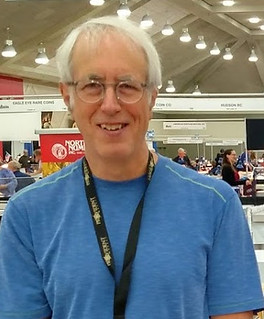 TOM CALDWELL: Well, honestly, I find that a little surprising if you're saying
that's still the case these days with everything. I mean, you can get fresh fruit here
in New England from the West Coast, so coins have been transported around quite
a bit. But I can understand that years ago, because of course, New England was
settled long before Oregon was. But also, it makes some sense just that, I mean,
way back in the day, I was in somebody's attic and they found a hoard of 1853
large cents, which...I got to buy what I wanted. And so that presumably wouldn't
happen out in the Northwest. But I think today, I mean, like we're here in Concord,
there's a Concord Lexington Commem. I think I'm just as lucky to find a Concord
Lexington Commem at a California show as I am here at a Massachusetts show.
Because so many coins have been so distributed everywhere these days. But back
in the day, that's understandable.
TOM CALDWELL: Well, honestly, I find that a little surprising if you're saying
that's still the case these days with everything. I mean, you can get fresh fruit here
in New England from the West Coast, so coins have been transported around quite
a bit. But I can understand that years ago, because of course, New England was
settled long before Oregon was. But also, it makes some sense just that, I mean,
way back in the day, I was in somebody's attic and they found a hoard of 1853
large cents, which...I got to buy what I wanted. And so that presumably wouldn't
happen out in the Northwest. But I think today, I mean, like we're here in Concord,
there's a Concord Lexington Commem. I think I'm just as lucky to find a Concord
Lexington Commem at a California show as I am here at a Massachusetts show.
Because so many coins have been so distributed everywhere these days. But back
in the day, that's understandable.
GREG BENNICK: Yeah. And I think that what maybe has transpired, and I'm just guessing, is that there's people, I know that I'm connected to colonial New England roots, having grown up in Connecticut. But people out here simply are not. So maybe the connection to collecting that has not become as popular here. I mean, I might have overstated that there'd be no colonial coins at a show. There just wouldn't be the preponderance of them that you see at a show, say, in Boston or New Hampshire.
TOM CALDWELL: That sounds right. And I think there's also more dealers from this part of the country that are likely to have some colonials. But yeah, so that sounds right. Honestly, we've always dealt in everything from colonials to territorial gold and everything in between. Just enjoy the variety.
 GREG BENNICK: Well, the website, I mean,
www.northeastcoin.com is
awesome. I love it. I love the interface. I love just going to the site and browsing,
buying things. It's fantastic. So, you mentioned a whole wide variety of coins.
What are your favorite coins personally? What do you enjoy most?
GREG BENNICK: Well, the website, I mean,
www.northeastcoin.com is
awesome. I love it. I love the interface. I love just going to the site and browsing,
buying things. It's fantastic. So, you mentioned a whole wide variety of coins.
What are your favorite coins personally? What do you enjoy most?
TOM CALDWELL: Well, I could say the next deal I'm going to make some good money on, but something in particular, we have always gone towards, always enjoy mint errors. That's been a favorite. Early coins, as you mentioned, can't go wrong with early coins, early Americana. So, I would say those would be a couple of particular ones.
GREG BENNICK: And I will offer an endorsement that the mint error selection on your website is always top notch. And I just always see things there, every once in a while, find something to buy. But there's always an amazing selection of mint errors on your site.
TOM CALDWELL: Well, thank you. Yeah, we'll try to keep up the good work.
GREG BENNICK: Now, one thing that you do on your site, which is really interesting, is that you allow people to make offers at times on certain coins. Can you tell me about that and how that came about?
TOM CALDWELL: Sure. Well, our site is largely treating it somewhat like a
coin show. And we want the inventory to keep moving. So, after a certain number
of weeks, there'll be something that they can click - or something underlined -
where someone looking at our site can see they're allowed to make an offer. And
we'll come back at our best price or it might be negotiated further. And we get a lot
of compliments on folks that just like that fact. We're not going to be hard-headed
about it, this is the price and that's it.
But also, of course, a lot of things
disappear right away from our site. They don't stick around. We have customers
that are looking at the site multiple times daily. Some of them, I think, I wish they
probably should get a life, but it works for us. (laughter)
GREG BENNICK: I'm glad. I know that there are specific things that I'm looking for that I have alert messages set with you. That every once in a while, I'll get an alert and I'll go and look at the coin. And there was one Standing Liberty quarter that I think I bought within a minute of you sending the alert last time. So, I enjoy that very much.
TOM CALDWELL: That works also. It's easy to say, I'm looking for a 1927S
quarter or a Pan Pac half dollar,
or whatever. And they'll get that email if they've
done that. And it helps. We've had our site since, we have one of the oldest coins
sites, and we have been improving it since about year 2000, or 1999 or so. In fact,
we just did a major upgrade. It's been almost two years in the making, which the
public won't see much difference, but they can, like some other sites do, they can
look back and see anything they've bought in the last 20 years. You can now go to
our site to look at it. We work on the site every day. And of course, not just adding
new material, but we work to improve it all the time.
GREG BENNICK: What is it about mint errors that you've been attracted to over the years? Because I'm a mint error collector, certainly. What is it about mint errors that you've liked? You mentioned that first.
TOM CALDWELL: Well, just the oddity of them. Every one is different, essentially. It's a specialized field, but we've always enjoyed dealing with them pretty much no matter what they are. The varieties and the mint errors.
GREG BENNICK: Great. Now, I was going to ask, and this is almost like a general question in a way, but I would love your perspectives on it. The timeline of the hobby since you started collecting and the sort of changes and highlights and fads and trends that come up, I would just love to know from your perspective, what are the things that jump out to you most say, about coin shows and how they've changed, or we could talk about grading trends as well. You don't have to combine them into one answer. But I'm just curious about the changes you've seen over the years and how it's impacted your perspectives on the hobby. Say if we were to talk about grading, for example, and how that's changed over the last 40-some years, what are your perspectives on that? Or your thoughts about grading and where we're at and where we've been?
TOM CALDWELL: Yeah. Well, I think PCGS and NGC coming along as a major grading services have been good for the business. It used to be somebody would call up and say, what does the coin look like? And I'd say, well, hold it up to the phone and we'll tell you a little bit closer (laughter) But now, I mean, with the standardized grading, everybody taking into consideration the | to 70 scale, it's only helped our business. It's eliminated some shysters out there that back in the day could just call coins whatever they wanted to. And with that said though, there have been some changes along the way where the standards have like loosened up a little bit. Not something the grading companies would really admit, but it used to be like a deep dark secret, but now it's pretty well known. But there's been adjustments to that. And while we're talking about grading, of course, I think that was the major thing over the years that really changed the business. Introduction of the grading services. And you have to give David Hall an awful lot of credit for coming up with that originally. And even just as important is the registry sets. That wasn't so much that he came up with the idea of putting the coins in the holders. It was also that he came up with a registry set for this. He's got tens of thousands of people competing with each other out there. That's been a big plus.
GREG BENNICK: People love competition. They certainly do. And they love it in any way. So, whoever would have thought that we could compete with coins. It's really interesting.
TOM CALDWELL: That's right.
GREG BENNICK: So, you're talking about gradeflation, as people say, and the inflation over time. It's interesting. What do you think has caused that? It's easy to surmise maybe, but I'm not exactly sure. What do you think has caused that gradeflation? If you and I were standing around in 1986 with a display of Morgan dollars, say, and $10 gold pieces in front of us, all uncirculated. Those would grade differently than, say, if we did the exact same exercise today, perhaps. What do you think has caused that?
TOM CALDWELL: Well, I think part of it has been that coins have gone up in price a lot. So, when, let's say, a $50 coin back 40 years or so ago might be a $500 coin today, there might be a tendency to grade things a little bit different and to refine it. That's why there's signs that came along about probably 15 years or so ago and other such designations that the grading services have had.
GREG BENNICK: Yeah. It seems that the addition of a plus or star certainly has added to the numerical grading scale, certainly. Of course, that gradeflation you mentioned earlier, that it seemed to be metered a bit. Meaning, have you noticed that people are aware of that and they've made changes? And I don't mean to single out any grading company in particular, but we all do it. I'm sure that grading standards have shifted for all of us. Have you noticed maybe a pulling back on the flexibility of grading recently at all?
TOM CALDWELL: I would say to some degree that's true. And I mean, it's long been said that grading it's not an art. It's subject to people's interpretation of what it is. So, it's just likely to change over time. And also, with dealers submitting coins for walkthrough service, might be some tendency for the graders to want to give it a little extra grade over time. But I think it has evened out.
If we jump way to the future, of course, there's a new CAC grading service, John Albanese, who has not been happy with the way coins are graded. It's interesting to see how that will play out.
GREG BENNICK: I'm definitely interested. Have they started as of now, March 2023, have they started grading coins yet? I don't think they have.
TOM CALDWELL: They have not. I mean, they keep on putting it off because they want to get it right, supposedly. They said it would be before the end of last year, but now it's probably a few months out, I'm guessing, but we shall see.
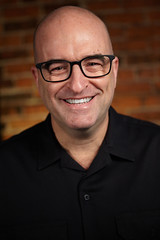 About the Interviewer
About the Interviewer
Greg Bennick (www.gregbennick.com) is a keynote speaker and long time coin collector with a focus on major mint error coins. Have ideas for other interviewees? Contact him anytime on the web or via instagram @minterrors.
To watch the complete video, see:
Tom Caldwell Interview
(https://nnp.wustl.edu/library/book/633370)
To read the complete transcript, see:
Tom Caldwell Interview (Transcript)
(https://nnp.wustl.edu/library/book/633369)
To read the earlier E-Sylum article, see:
TOM CALDWELL INTERVIEW, PART ONE
(https://www.coinbooks.org/v26/esylum_v26n53a15.html)
TIBET MUSEUM'S NUMISMATIC EXHIBIT
A Tibet Museum has opened a temporary numismatic exhibition. -Editor
The exhibition, curated by Tenzin Topdhen and Ngawang Dorjee, explores Tibet's numismatic legacy, unraveling its cultural and historical tapestry through coins and currency. It highlights the evolution of Tibetan currency as a tangible reflection of the region's diverse influences, providing a unique insight into Tibet's past. The showcased artefacts include Tibetan coins with distinct designs that symbolise aspects of Tibet's independence, spirituality, history, and daily life. Additionally, the exhibition delves into the influence of neighbouring cultures, highlighting the region's interconnections with the broader Asian context.
To enhance the visitor experience, the exhibition fosters a deeper appreciation of Tibet's currency through interactive displays, multimedia presentations and testimonials. The exhibition not only celebrates the artistic and historical value of Tibet's currency but also fosters a deeper understanding of Tibet's diverse cultural identity.
The inaugural ceremony was attended by many visitors, indulging in various discussions. The ceremony concluded with remarks from Tenzin Topdhen, the director of Tibet Museum, who stated that the numismatic heritage of Tibet is specifically significant for its representation of Tibet's independence
.
To read the complete article, see:
Kalon Norzin Dolma Inaugurates Tibet Museum's Temporary Exhibition Titled Numismatic Heritage of Tibet
(https://tibet.net/kalon-norzin-dolma-inaugurates-tibet-museums-temporary-exhibition-titled-numismatic-heritage-of-tibet/)
KüNKER SALE 400 HIGHLIGHTS
Künker's auction sale 400 closes February 1st. Here's the press release. Some nice coins. -Editor
Künker's 400th Auction Sale: A Firework of Numismatics
On 1 February 2024, the World Money Fair kicks off with Künker's 400th auction. Look forward to a firework of rare coins and medals!
770 lots with a total estimate of more than 7 million euros – do you even need to hear more to get excited about Künker's 400th auction sale that kicks off the World Money Fair on 1 February 2024? Yes, you do! After all, the Osnabrück auction house will once again offer a selection of exquisite coins and medals that are hardly ever found on the market.
Selected lösers from the Popken Collection
Künker's auction 400 starts with another part of the Popken Collection. On offer are 39 lösers, including spectacular pieces such as a 1583 Julius löser minted in Wolfenbüttel, or Heinrichstadt as it was called at the time. Another magnificent example from this collection is a 1679 löser of three reichstalers, minted in Zellerfeld on behalf of Prince Rudolph Augustus of Brunswick Wolfenbüttel.
No. 2: Brunswick and Lüneburg. Julius, 1568-1589. 1583 löser of 10 reichstalers, Heinrichstadt (Wolfenbüttel). From the Friedrich Popken Collection. Extremely rare. Very fine. Estimate: 50,000 euros
No. 16: Brunswick and Lüneburg. Rudolph Augustus, 1666-1685. 1679 löser of 3 reichstalers, Zellerfeld. From the Friedrich Popken Collection. Extremely rare. Extremely fine. Estimate: 40,000 euros
Rarities from the German States
Let us stay at the German states. The spectrum of rarities offered in this section ranges from Anhalt to Württemberg and also includes Austrian princes. No matter what field of the German states you are interested in, you can be sure that you will find a very special piece in this catalog. River gold ducats, multiple gold coins, rare and historically interesting medals, and spectacular talers: take your time to leaf through the catalog – you will find exciting pieces such as a showpiece of an extremely rare reichstaler of the Great Elector Frederick William of Brandenburg from 1684, an even rarer and earlier taler by William V of Jülich-Berg or a quadruple ducat by Simon Henry of Lippe, to name but a few examples.
No. 64: Bavaria. Ludwig I, 1825-1848. 1830 ducat. Danube river gold. Very rare. Extremely fine to FDC. Estimate: 15,000 euros
No. 82: Brandenburg-Prussia. Frederick William, the Great Elector, 1640-1688. 1684 reichstaler IE, Magdeburg. Very rare. About FDC. Estimate: 40,000 euros
No. 131: Hamburg. 1/4 portugalöser worth 2 1/2 ducats n.d. (1578-1582) NGC MS61. Very rare. Extremely fine +. Estimate: 20,000 euros
No. 149: Jülich-Berg. William V, 1539-1592. Taler n.d. (ca. 1540), Mülheim. Extremely rare. Extremely fine. Estimate: 35,000 euros
No. 163: Lippe. Simon Henry, 1666-1697. 4 ducats 1685 (minted in 1685/86), Detmold. From the dies of the ducat. Extremely rare. Extremely fine. Estimate: 60,000 euros
No. 241: Saxe-Hildburghausen. Ernst, 1680-1715. 1708 reichstaler, probably Coburg mint. Probably the 2nd known specimen. Extremely fine. Estimate: 35,000 euros
No. 281: Württemberg. Julius Frederick, administrator and guardian of Eberhard III, 1631-1633. 1631 reichstaler, Stuttgart. Very rare. About extremely fine. Estimate: 25,000 euros
French Showpieces
Next is the section of world coins, including a plethora of impressive pieces. They are all characterized by their rarity and outstanding quality. Furthermore, some of the pieces are of great numismatic significance or have a far-reaching provenance to show for themselves. The small series of French issues, for example, only
contains about 30 lots. However, they include so many exceptional pieces that it is hard to decide which ones to include in this preview. We decided on a very rare variety of the double louis d'or of Louis XIII. The extremely fine piece was minted in 1640 in Paris. It shows an impressive portrait of the ruler who is known as the patron of the Musketeers in popular culture.
Our second example was created in the county of Dombes under the rule of Louis III de Bourbon-Montpensier, one of the great opponents of the Huguenots. He played an active role in the run up to Bartholomew's Day massacre. Almost even more remarkable than the general on the obverse are the minting tools and the circumscription on the reverse, which explains that workers at mints can pass without paying taxes.
No. 460: France. Louis XIII, 1610-1643. 1640 double louis d'or 1640, Paris. Very rare. Extremely fine. Estimate: 40,000 euros
No. 481: France. Dombes. Louis II de Bourbon-Montpensier, 1560-1582. 1576 ecu d'argent. Probably the 2nd known specimen. Very fine to extremely fine. Estimate: 25,000 euros
British Multiple Gold Coins
Five Guineas are among the most popular collectibles when it comes to British coins. Auction 400 presents a rich selection of these pieces. However, the highlight of this section was created a little later. It is a pattern for the 5-pound piece of 1820 with smooth edge. Only a total of 25 specimens were created of this pattern, most of which do not have a smooth edge but an edge inscription. Only two pieces are known of the smooth-edge patterns today!
No. 494: Great Britain. William III, 1694-1702. 5 guineas 1701, London. Rare. NGC MS61. Extremely fine to FDC. Estimate: 60,000 euros
No. 497: Great Britain. George III, 1760-1820. Pattern 5 pounds 1820, London. Pattern with smooth edge. NGC PF64*CAMEO (Top Pop). Only two specimens known. Proof. Estimate: 150,000 euros
Italy from Frederick II to Victor Emmanuel III
The small selection with Italian pieces also has many treasures to offer! From medieval grossi of exceptional quality to impressive Renaissance portraits and extremely rare pieces from the era of Napoleonic rule: these coins reflect Italy's diverse and rich history, which makes the country one of the most popular tourist destinations to this day. There are also many coins on offer that were created after the unification and that can only be encountered on rare occasions. For example a piece from 1901. The Italian 5-lira pieces had to be melted down due to an intervention of France. Only 114 specimens escaped this fate. The king, who was a passionate coin enthusiast, made sure that the pieces were given to the most important coin collectors of the time.
No. 512: Como. Frederick II, 1250-1280. Grosso da 6 denari n.d. Very rare. About extremely fine. Estimate: 10,000 euros
No. 523: Milan. Charles V, 1535-1556. Testone n.d. Commemorating the senate of Milan paying homage to the emperor. Very rare. About extremely fine. Estimate: 6,000 euros
No. 529: Naples and Sicily. Joachim Murat, King of Naples, 1808-1815. 40 franchi 1810, Naples. Variety without N.M. at the neck section. NGC AU55 (Top Pop). Extremely rare. Extremely fine. Estimate: 75,000 euros
No. 553: Kingdom of Italy. Victor Emmanuel III, 1900-1946. 5 lire 1901, Rome. Very rare. About FDC. Estimate: 50,000 euros
Poland, Russia, Czechia, Transylvania
By tradition, many coin dealers and collectors from Eastern Europe travel to Berlin to participate in Künker's auction sale. They can look forward to a rich offer that goes far beyond what is usual. Be it Poland, Czechia, Transylvania or Russia – the coins and medals on offer from these countries are among the great rarities of numismatics.
Let us begin with an example from Poland, a gold medal by Sigismund III Vasa, the Swedish king on the Polish throne. The wonderful medal created in the late Renaissance period depicts the baptism of Jesus in the Jordan River on the reverse. This motif was a unique compromise for the ruler, who governed Protestant Sweden and Catholic Poland at the same time.
The two examples from Russia that will be presented here are among the rarest pieces of Russian numismatics. The 1801 ruble is a pattern from St. Petersburg. Regarding its fineness, the 37 1/2 rubles from 1902 exactly corresponded to 100 francs of the Latin Monetary Union. Only 225 specimens were issued to be used as gifts.
There is a lot on offer for Czech collectors, including numerous gold coins from Czechoslovakia as well as a royal d'or by John of Luxembourg from 1337. The blind king, who fell at the Battle of Crécy, was the father of Charles IV. This royal d'or is the only specimen on the market.
Let us round off our trip to Eastern Europe with a 10-fold ducat by Sigismund Rákóczi, the flamboyant figure of Transylvanian history that owed his title both to the recognition of the imperial court and that of the Ottoman sultan. Particularly remarkable is the weapon the hero of the Long Turkish War carries on this coin: a mace.
No. 584: Poland. Sigismund III, 1587-1632. 1596 gold medal of 5 ducats, probably Poznan. NGC AU58 (Top Pop). Extremely rare. About extremely fine. Estimate: 100,000 euros
No. 593: Poland. Torun. 2 ducats 1664. PCGS MS63 (Top Pop). Very rare. Extremely fine to FDC. Estimate: 50,000 euros
No. 631: Russia. Alexander I, 1801-1825. 1801 ruble, St. Petersburg. Pattern. Very rare. Extremely fine to FDC. Estimate: 100,000 euros
No. 642: Russia. Nicholas II, 1894-1917. 37 1/2 rubles (100 francs) 1902, St. Petersburg. Only 225 specimens minted. First strike, about FDC. Estimate: 150,000 euros
No. 686: Czechia / Bohemia-Moravia. John of Luxembourg, 1310-1346. Royal d'or n.d. (1337), minted for the County of Luxembourg. The only specimen on the market. Extremely fine. Estimate: 75,000 euros
No. 700: Czechoslovakia. 5 ducats 1934, Kremnica, commemorating the re-opening of the Kremnica mines. Original strike. NGC 63PL. Only 70 specimens minted. First strike, about FDC. Estimate: 10,000 euros
No. 705: Hungary / Transylvania. Sigismund Rákóczi, 1607-1608. 10 ducats 1607. NGC AU55+. Extremely rare. About extremely fine. Estimate: 100,000 euros
Far East and the USA
Let us conclude this auction preview with a glance at the specimens from overseas
. Connoisseurs will be delighted by the small run of rare and exquisite Chinese coins. A Japanese oban from the Man'en era will also be met with great interest.
The auction will be rounded off by a small series of US gold coins.
No. 719: China. Republic. 1 dollar year 12 (1923), probably for the wedding of the former ruler Henry Pu Yi. NGC MS61. Very rare. Extremely fine to FDC. Estimate: 20,000 euros
No. 725: Japan. Man'en era. Oban without year (1860-1862). Very rare. Extremely fine. Estimate: 12,500 euros
No. 760: USA. 20 dollars 1907, Philadelphia. High relief. Very rare. About FDC. Estimate: 10,000 euros
In the context of the Berlin auction sale, on 5 and 6 February 2024 Künker's eLive Premium Auction 401 will be held showcasing coins and medals featuring multiple portraits
from a private collection in Westphalia.
To order a catalog contact Künker, Nobbenburger Straße 4a, 49076 Osnabrück; phone: +49 541 / 962020; fax: +49 541 / 9620222; or via e-mail: service@kuenker.de. You can access the auction catalogs online at www.kuenker.de. If you want to submit your bid from your computer at home, please remember to register for this service in good time.
NUMISMATIC NUGGETS: JANUARY 7, 2024
Here's a selection of interesting or unusual items I came across in the marketplace this week. Tell us what you think of some of these. -Editor
Society of Music Friends Medal
Art Nouveau medal by Schafer&Hartig 1912 Society of Music Friends Vienna 7,5 cm
A great medal I hadn't seen before. -Editor
To read the complete lot description, see:
Art Nouveau medal by Schafer&Hartig 1912 Society of Music Friends Vienna 7,5 cm
(https://www.ebay.com/itm/256357867894)
1907 Ten Dollar Fantasy Coin
This week I came across a couple interesting "Commemorative Replica" coins. Things like this have been around a while and will someday flood the market, but at least they're not at all deceptive and a clearly labeled "COPY" per the Hobby Protection Act. I'd call them fantasies rather than copies. -Editor
To read the complete item description, see:
replica coin 5pcs/set 1907 Indian Head Modern Crafts Copper Great American Commemorative Old Coin Suitable For Collection Gift Replica Coin
(https://www.temu.com/5pcs-set-1907-indian-head-modern-crafts-copper-great-american-commemorative-old-coin-suitable-for-collection-gift-replica-coin-g-601099534353814.html)
Hobo Fantasy Coin
I only sell copy (replica) coins, Please don't buy them as the original coins. I sell these copied coins only want to make your collections more perfect.
Cool "hobo nickel style" piece, clearly not a genuine coin. -Editor
To read the complete item description, see:
replica coin United States Hobo Coin, Commemorative Copy Commemorative Coin, Replica Collection Coin, Gifts
(https://www.temu.com/united-states-hobo-coin-commemorative-copy-commemorative-coin-replica-collection-coin-gifts-g-601099537076237.html)
Dutch Naval Fleet Medal Paperweight
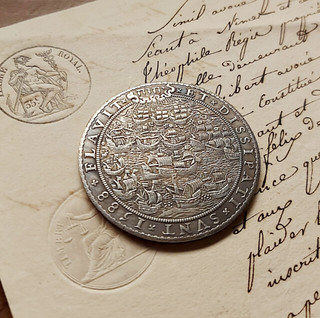 Paperweight - 900 silver (38.1gr). Dutch naval fleets
Paperweight - 900 silver (38.1gr). Dutch naval fleets
ABOUT THE ITEM
Indies Company. Circular paperweight, replica of the medal in 900 silver, weight approximately 38.1 grams, diameter approximately 50mm. Artistic commemoration of the Dutch naval fleets 1588. It will be shipped in a soft velvet case. The medal may have stains and signs of aging. Safe and fast shipping.
This item may be more deceptive. They call it a "paperweight". Seems nicely done and marketed, though. What medal is it a replica of? -Editor
To read the complete lot description, see:
Paperweight - 900 silver (38.1gr). Dutch naval fleets
(https://www.catawiki.com/en/l/78511369)
1919 Russia 10,000 Rubles
Russia. 1919 (ND 1920). 10,000 Rubles, P-106b, Issued banknote, Red on purple and m/c underprint, back is m/c with arms at center, S/N GKH559717, Watermark: Narrow Waves, PMG graded Choice Extremely Fine 45.
Workers of the world, unite! From the upcoming Archives International sale. -Editor
To read the complete lot description, see:
Russia. Currency Note, 1919 (ND 1920), Issued Banknote
(https://auction.archivesinternational.com/Russia-Currency-Note-1919-ND-1920-Issued-Banknote_i51400229)
THE COIN THAT SHOULDN'T EXIST
Mike Markowitz passed along this New York Times article about the scientific examination of an impossible coin. Thanks. Here's an excerpt - see the complete article online. -Editor
A decade ago, a funny money mystery fell into the hands of scientists and students at the Pontifical Catholic University of Peru in Lima.
The university had been acquiring 19th- and 20th-century Peruvian coins from local dealers, and graduate students in the chemistry department were analyzing the pieces for their thesis work. But one coin, a 10-cent piece known as a dinero, stood out.
The dinero was marked 1899.
The problem was that official records indicated no coins of that denomination were minted in Peru that year — according to the people who made the money, the coin never existed.
Most international coin catalogs don't list 1899 dineros, said Luis Ortega, a chemist at the university. And in the rare cases that they do, there is often only a note of counterfeit
with no further detail, Dr. Ortega said. No one was able to provide more information about it.
Now Dr. Ortega and Fabiola Bravo Hualpa, a doctoral student, believe they have shed new light on the mystery of the coin that came from nowhere. In a paper published last year in the journal Heritage Science, they described how they subjected one of the two known 1899 dineros to a barrage of scientific analyses, illuminating its possible origins and the role it might have played during an unstable era of South American history.
To the naked eye, the 1899 coin resembles other dineros: It's silver in color and features the same coat of arms and seated woman that represents the goddess of liberty. And it's remarkably similar in size to other dineros minted around the turn of the 20th century — about the dimensions of a U.S. dime.
But when Dr. Ortega and Ms. Bravo Hualpa bombarded the 1899 coin with X-rays and measured the light it re-emitted, they determined that the dinero was largely made of copper, zinc and nickel. This alloy is known as nickel silver. It's commonly used to make silverware and ornamental objects and has a silvery appearance, but it contains no silver. Genuine dineros produced by the Lima Mint, on the other hand, are roughly 90 percent silver.
Circulating contemporary counterfeits are no mystery to experienced collectors, and recently the field has gotten more attention through the work of authors such as Winston Zack. It's nice to see the scientific community addressing the field as well. -Editor
To read the complete article, see:
The Mystery of the Coin That Shouldn't Exist
(https://www.nytimes.com/2024/01/07/science/dinero-peru-coin-1899-counterfeit.html)
To read earlier E-Sylum articles, see:
NEW BOOK: BAD METAL
(https://www.coinbooks.org/v22/esylum_v22n31a07.html)
NEW BOOK: BAD METAL: SILVER 3 TO 25 CENTS
(https://www.coinbooks.org/v25/esylum_v25n32a06.html)
LINCOLN CENT MULED WITH A ROOSEVELT DIME
Here's another Coin That Shouldn't Exist - a Lincoln cent muled with a Roosevelt dime reverse, being auctioned by Heritage in their FUN sale this week. Here's the lot description. -Editor
2001-D Lincoln Cent -- Muled With a Roosevelt Dime Reverse -- MS66 Red PCGS. A mule is a coin struck from mismatched dies. In the long history of the U.S. Mint, if patterns are excluded, a total of perhaps 30 mules are known. Best known of all is the circa 2000 "golden" dollar / quarter mule that pairs a Washington state quarter obverse and a Sacagawea dollar reverse on a Sacagawea dollar planchet. About twenty examples of that mule are confirmed, and they regularly command six figures at auction. The state quarter / Sacagawea dollar mule is ranked #1 in the 100 Greatest U.S. Error Coins reference.
Among a multitude of mule possibilities, the Lincoln cent / Roosevelt dime mule is most likely to occur. The diameters for the cent and dime are similar, and both types have annual mintages that often exceed a billion or more pieces. Nonetheless, mules are great rarities. We know of only seven cent / dime mules:
- A 2001-D Lincoln cent obverse and a Roosevelt dime reverse on a Lincoln cent planchet. The present coin.
- Another. MS65 Red PCGS. Long Beach Signature (Heritage, 2/2022), lot 3133.
- Another. MS65 Red PCGS. Dallas Signature (8/2022), lot 3984.
- Another. MS66 Red PCGS. Long Beach Signature (Heritage, 6/2021), lot 3158.
- A 1999 Lincoln cent obverse and a Roosevelt dime reverse on a Lincoln cent planchet. MS66 Red PCGS. Bellaire Collection; Central States Signature (Heritage, 4/2006), lot 5271.
- A 1993-D Lincoln cent obverse and a Roosevelt dime reverse on a Lincoln cent planchet. MS65 Red PCGS. Alfred V. Melson Collection; FUN Signature (Heritage, 1/2010), lot 2383.
- A 1995 Lincoln cent obverse and a Roosevelt dime reverse on a Roosevelt dime planchet. MS64 NGC. Alfred V. Melson Collection; FUN Signature (Heritage, 1/2010), lot 2384.
Probably, the four known 2001-D cent / dime mules were struck on the same day, by the same die pair, on the same press. The dime reverse on the present pumpkin-gold example has a broad rim with raised and recessed elements. The wider rim on the reverse is caused by the comparatively narrow diameter of the dime die. The letters in GOD WE TRUST are lightly brought up, but the remainder of the strike is sharp.
Heritage has auctioned all four known examples of the 2001-D cent / dime mule, and it is interesting to compare images of the four coins. The present lot appears to possess the best eye appeal, because the other three coins display many minuscule toning flecks. The planchet was well prepared, without the tiny trapped gas bubbles that affected the #3 coin from the list above. An important opportunity for the advanced error specialist.
To read the complete lot description, see:
2001-D Lincoln Cent -- Muled With a Roosevelt Dime Reverse -- MS66 Red PCGS....
(https://coins.ha.com/itm/errors/2001-d-lincoln-cent-muled-with-a-roosevelt-dime-reverse-ms66-red-pcgs/a/1371-4450.s)
To read a nice CoinWeek article by Charles Morgan, see:
This Rare Lincoln Cent Roosevelt Dime Mule Is Worth $100,000 or More
(https://coinweek.com/rare-lincoln-cent-roosevelt-dime-reverse-mule-worth-100000-or-more/)
THE BOOK BAZARRE
AUSTRALIA MINTS WORLD'S 1ST COIN IN 2024
Happy New Year, everyone. Before midnight arrived here on the U.S. East Coast, Don Cleveland of Australia passed along a story about the Royal Australian Mint's striking of the first coin in 2024. -Editor
Twelve-year-old Izzy Zaharis (at center) with astrophysicist Brad Tucker of the Australian National University and Mount Stromlo Observatory in Canberra representing the Australian Space Agency (at left) and Royal Australian Mint chief executive officer Leigh Gordan after she won the chance to strike the first coin of 2024, a collectible dollar with the theme "Out of this World - Australia in Space."
The world's first coin to be struck in 2024 highlights Australian space exploration history.
"Out of this World - Australia in Space" was chosen by the Royal Australian Mint as its 2024 theme "to showcase Australia's history and significance as one of the earliest nations to launch its own satellite."
The coin's reverse, or tails side, depicts an Australian astronaut on a spacewalk and the launch of WRESAT-1 on a modified U.S. Redstone rocket in 1967. The satellite, which carried upper atmospheric radiation measurement experiments, established Australia as the seventh nation to put a satellite into orbit and the third country to launch from its own territory, after the Soviet Union and United States.
The coin's design also includes Earth, with the Australian continent clearly visible, and the moon, the latter an homage to the country's role in relaying the live television signal during Apollo 11, the first moon landing, and to an Australian-built robotic rover that will explore the lunar surface as part of NASA's Artemis program.
Along the border of the coin's reverse are inscribed the words, "rovers, technology, rockets, astronauts, satellites, communications, GPS, astronomy, exploration and discovery."
The mint worked with the Australian Space Agency to design the coin.
To read the complete articles, see:
Australia celebrates space history on world's 1st coin minted in 2024
(https://www.space.com/royal-australian-mint-out-of-this-world-2024-coin)
Izzie mints world's first 2024 coin in Canberra
(https://www.canberratimes.com.au/story/8473469/twelve-year-old-izzie-mints-australias-first-coin-of-2024/)
HARRIET TUBMAN COMMEMORATIVE COINS
There was a flood of mainstream articles this week about the new commemorative Harriet Tubman coins. Among the first was this National Public Radio piece. -Editor
 Three commemorative coins featuring famed abolitionist and human rights activist Harriet Tubman have now been released to the public, the U.S. Mint said.
Three commemorative coins featuring famed abolitionist and human rights activist Harriet Tubman have now been released to the public, the U.S. Mint said.
The coins, which were released Thursday as part of the Harriet Tubman Commemorative Coin Program, include $5 gold coins, $1 silver coins and half-dollar coins that honor the bicentennial of her birth.
The designs featured on the coins follow the three periods of Tubman's life and her work as an abolitionist and social activist.
"Every coin produced by the United States Mint helps to tell a story that teaches us about America's history or connects us to a special memory," U.S. Mint Director Ventris Gibson said in a statement.
Gibson signed 250 Certificates of Authenticity for the 2024 Harriet Tubman Three-Coin Proof Set, which will be randomly inserted into unmarked sets, the U.S. Mint said.
The silver dollar design portrays Tubman's time as a "conductor" on the Underground Railroad. The half-dollar design showcases Tubman holding a spyglass in front of a row of Civil War-era tents, symbolizing her work as a scout and spy for the Union Army during the Civil War.
The $5 gold coin design represents Tubman's life after the Civil War, as she is shown "gazing confidently into the distance and towards the future," the U.S. Mint said in its description.
The release of Tubman's commemorative coin comes on the heels of continuous efforts by some lawmakers to replace President Andrew Jackson with the abolitionist on the $20 bill, after previous attempts to do so failed.
The Biden administration announced in January 2021 that it would resume efforts to redesign the $20 bill to feature Tubman, saying they were "exploring ways to speed up that effort."
So far, there have been no updates from the administration on the progress of the bill's redesign.
To read the complete article, see:
The U.S. Mint releases new commemorative coins honoring Harriet Tubman
(https://www.npr.org/2024/01/04/1222896091/harriet-tubman-us-mint-new-commemorative-coin)
Pablo Hoffman passed along a link to the original U.S. Mint press release. -Editor
The 2024 Harriet Tubman Commemorative Coin Program celebrates the bicentennial of Harriet Tubman's birth. Public Law 117-163, the Harriet Tubman Bicentennial Commemorative Coin Act, directs the U.S. Mint to issue $5 gold coins, $ 1 silver coins, and half dollar clad coins as part of the program.
Coin prices include surcharges of $35 for each $5 gold coin, $10 for each silver dollar, and $5 for each clad half dollar. The Public Law authorizes the surcharges to be paid to the National Underground Railroad Freedom Center in Cincinnati, Ohio, and the Harriet Tubman Home, Inc., in Auburn, New York to advance their missions.
I like these designs, particularly the use of negative space to depict people on the dollar. Nicely done. -Editor
To read the complete article, see:
Harriet Tubman Commemorative Coin Program
(https://www.usmint.gov/learn/coin-and-medal-programs/commemorative-coins/harriet-tubman)

The coins are also marketed on the Mint website's page for African American Coins & Medals. Given our earlier discussions of Mint coin bags I appreciated seeing the site's version of a shopping cart. -Editor
To visit the African American Coins & Medals page, see:
African American Coins & Medals
(https://catalog.usmint.gov/african-american-coins-medals/)
TAMPA'S BREADCOIN TOKENS
Charity tokens are nothing new, but the concept seems to get reinvented every generation or two. Tampa, FL is the latest city to adopt "Breadcoin" tokens. Found via News & Notes from the Society of Paper Money Collectors (Volume IX, Number 29, January 2, 2024) -Editor
The Tampa Downtown partnership is working with several restaurants and food trucks to offer those in need with a unique currency to use at select locations. It's called Breadcoin.
According to the founders of Breadcoin, the token is worth $2.50 and works like a community-wide gift certificate at participating food vendors.
June Brown, a homeless liaison for the Tampa Downtown Partnership, walks around several blocks speaking with homeless and offers them a meal using the coins.
These bread coins are the best thing. You don't have to worry about them saying ‘hey, excuse me, do you have a dollar? Do you have any money you can spare?',
Brown said.
Brown will ask someone in need if they are hungry and either go and get them a meal or bring them along. It provides a homeless person a chance at having options on what to eat.
It gives them a sense of independence; they do something for themselves,
Brown said. It ensures you know where that money is going and it helps our small businesses in the long run, too.
The program first launched in February. It's funded by donations and corporate gifts. Several businesses, like Moxies Café, are participating.
So far, organizers are calling it a success and could expand the program to include more locations in the near future.
For more information, see:
https://breadcoin.org/
I believe we've discussed charity tokens from as early as the 1700s, but I'm having trouble finding articles in our archive. Is there a more general descriptive name for tokens used to give the poor in lieu of actual money? It's a demeaning practice if you ask me, but backers frame it as a way to encourage gifting from people who don't trust the recipients to spend it "properly" - i.e. for food, clothing etc. vs. liquor, drugs, gambling, etc. The Breadcoin site says they "ensure everyone has the dignity of choice," but tokens good only for certain products at certain places doesn't sound like "choice" to me. -Editor
To read the complete article, see:
Breadcoin' program in Tampa provides homeless with a unique currency
(https://www.baynews9.com/fl/tampa/news/2023/12/27/a-program-in-downtown-tampa-provides-homeless-with-a-unique-currency-)
To read earlier E-Sylum articles, see:
NUMISMATIC NUGGETS: DECEMBER 24, 2017 : 1904 Beirut Charity Token
(https://www.coinbooks.org/v20/esylum_v20n53a14.html)
NOTES FROM E-SYLUM READERS: DECEMBER 31, 2017 : More on Charity Tokens
(https://www.coinbooks.org/v20/esylum_v20n54a11.html)
THE INIMITABLE NOTE COMPETITION
A Bank of England museum article by curator Jennifer Adam discusses the famous satirical money art of George Cruikshank and the ensuing ‘Inimitable Note competition' to make banknotes harder to counterfeit and less tempting to small-time criminals who were being caught and hanged in record numbers. -Editor
At this time, the quality of banknotes was inconsistent. The Bank often re-engraved old, worn printing plates to produce the notes more quickly. More than 700,000 banknotes were issued in the month after the crisis. Forgers took advantage of people's unfamiliarity with the banknotes and the unreliable quality of notes, and the number of counterfeits surged.
By law, the punishment for counterfeiting or trying to use forged banknotes could be death. Between 1797 and 1817, more than 300 people were sentenced to death for banknote counterfeiting offences.
Sometimes, those caught with counterfeits were charged with the slightly less serious offence of ‘being in possession of forged Notes'. The penalty for this was transportation to penal colonies in Australia, rather than hanging.
People felt that the Bank of England enforced harsh punishments, but also did not do enough to make its banknotes difficult to counterfeit. In 1819 George Cruikshank made a parody of a banknote which criticised the Bank's harsh policy of hanging or transporting convicted counterfeiters even though its notes were ‘easily imitated'. The ships represent the transportation of people who were caught with forged notes. The banknote is signed ‘Jack Ketch', which was a nickname for the hangman.
From 1817, various committees were set up to research ways the Bank could make the design of its notes more secure. Many craftsmen competed to create designs that could not be copied and submitted them to the Bank of England for consideration. This became known as the ‘Inimitable Note competition'.
To make sure the banknotes were difficult to copy, the Bank of England employed engravers to test the designs submitted to the Inimitable Note competition. The Bank reasoned that if they could make a good-quality copy of the design, so could counterfeiters.
Eventually only one firm remained in the competition, Applegath & Cowper, who were producing notes printed in several colours and with very complicated geometric patterns. Yet despite this, the Bank's engravers were able to make almost indistinguishable copies. Plus, the designs were so complicated, they were difficult to read.
So the Bank decided to retain its existing design, but it made one very important change – not to the design, but to the paper. Paper-maker William Brewer created a complex new watermark with waved horizontal and vertical lines. It was too complex and costly for most counterfeiters to attempt. The material the banknote was made of became – and remains – as important to the security of the note's design as anything that was printed on it.
To read the complete article, see:
Inimitable notes: The quest for the perfect banknote
(https://www.bankofengland.co.uk/museum/online-collections/blog/inimitable-notes-the-quest-for-the-perfect-banknote)
THE JAMES W. FERRY TRAVEL NOTE
Stack's Bowers Currency Auction Associate Bradley C. Trotter published an article highlighting an interesting annotated dollar bill. -Editor
Paper money isn't simply a medium of exchange, but also a tangible testament to history. From courtesy autographs of Treasury officials to celebrities to the Short Snorters
of World War II, paper money can bear witness to history and help to preserve one's memory.
Although unusual in most respects, this note is not simply an accumulation of signatures collected from strangers, but a detailed listing of travels across Northern Europe.
It is attributed to James W. Ferry, a director of the Commercial Safety Deposit Company of Chicago and president of the City Cab Company. Ferry was a prominent citizen of Chicago in the latter half of the 19th century; he died at the age of 67 in 1897.
This note traces Ferry's journey across Europe during summer 1874, from his departure from New York aboard the RMS Oceanic at the end of May through his eventual return to Chicago in early September, after a return voyage on the SS Baltic. Ferry's journey followed a long and winding path through Ireland, England, France, Belgium, the Netherlands, Germany, Switzerland, Wales, and Scotland as detailed by his annotations. Included on Ferry's itinerary were notable destinations like Westminster Abbey, Windsor Castle, Bavaria, Berne, Paris, and Blarney Castle.
This note was eventually passed down through his sister who gave it to her grandson Richard Weston Patton in September 1956.
For collectors interested in this very special numismatic item, this note will be offered in our January 25, 2024, U.S. Currency Collectors Choice Online Auction. It presents a fascinating opportunity that is unlikely to be repeated owing to the unique nature of this lot.
While not as large and colorful as a short snorter, this personal travel record is a meticulous summary of an amazing trip. Plenty of banknotes get scribbled on, but these notes form a cohesive record. Great story piece. -Editor
To read the complete article, see:
A TESTAMENT OF ADVENTURE: THE MANY ANNOTATIONS OF JAMES W. FERRY
(https://stacksbowers.com/a-testament-of-adventure-the-many-annotations-of-james-w-ferry/)
CRAFTY COUNTERFEIT DISPLAY, PART ONE
John Regitko of Toronto, Canada submitted this two-part story of his adventure curating a paper money exhibit for the annual Canadian National Exhibition. Here's part one. Previously published in Canadian Coin News, it is republished here with permission. -Editor
ILLEGAL COUNTERFEIT DISPLAY AT SHOW LEADS TO ARREST
One of the exhibits mounted on the wall of the Coin Exhibit at the Arts Crafts Hobbies Building during one of the annual Canadian National Exhibition in Toronto was a display of how paper money was printed by the Canadian Banknote Company and the British American Banknote Company. It covered the printing process of the 1954 series of $1 notes in colour.
I set up the display during the days when the law stated that you could not reproduce banknotes in colour, regardless of the size of the images. (The legislation has changed where you can now legally reproduce images providing it is less than half or more than double actual size.)
Even though tens of thousands of people would view the exhibit, I was not concerned about anyone calling the police accusing me of counterfeiting and/or possession of counterfeit notes.
I had already done my due diligence prior to displaying it as a competitive exhibit at a convention held at the Westbury Hotel in Toronto.
The eight-case display, which are the first eight cases of the 12-case exhibit at the CNE shown in the photo, showed enlargements of the various stages of the printing process of the $1 notes of 1954, from the creation of the artwork, engraving, printing plates and to the printing of the various colours, serial numbers and signatures.
To avoid any potential problems for me, I decided to show the exhibit to Corporal Walton, in charge of counterfeiting of O
Division for the RCMP covering Toronto, before exhibiting it. This was just as well, as events eventually unfolded at the Convention.
I asked Corporal Walton for an opinion on its acceptability.
He asked me why I didn't come to him before I made up the display. I told him that it might be that either I didn't think at first that there would be a problem, or that I thought I might be told I couldn't do it and that, if I still decided to go ahead, I might be charged since I had been warned in advance.
He pulled out a copy of the Criminal Code of Canada, turned to the appropriate section, and started reading out loud the part about reproducing the likeness of Canadian paper money and/or possession thereof. When he was finished, he looked at the display and after some thought, suggested I contact the Fraud Squad of the Metropolitan Toronto Police Department who has overlapping jurisdiction in the Toronto area for matters involving counterfeiting.
I made an appointment with a detective at police headquarters and after showing him the exhibit and explaining that I wanted to exhibit it, he reached for a copy of the Criminal Code of Canada from the bookshelf behind him, turned to the appropriate section and read out loud the part about counterfeiting. He then asked me why I didn't call him before I made up the display. I gave him the same answer I gave to Corporal Walton at the RCMP.
He told me I should go and visit one of the attorneys in the Attorney General's Department at Queen's Park for an opinion. I called them and explained why I wanted an appointment.
A few days later, I took my display and walked up the stairs at Queen's Park, wondering what I had gotten myself into. But after all the time I spent making up the display, after showing it to the RCMP and the Toronto Police and making the Attorney General's Department aware of what I had been up to, I thought I better show up for my appointment.
After you tell them you printed paper money and you don't show up, you know what happens? You become a fugitive and they hunt you down.
After the usual preliminaries, I pulled out the display from my carrying case and showed it to him.
The next two words coming out of his mouth bothered me. He said: Oh, Boy!
That was it, Oh, Boy!
He sat there for a while staring at the display, then looked at me. I said I guess it's no problem. I'll just get out of your office so you can carry on with your work.
Obviously a two-word man, he said Sit Down!
in a stern voice.
I sat down.
He reached over to his library and pulled out a copy of...you guessed it...the Criminal Code of Canada.
Since by now I had become quite familiar with the appropriate section of the book, I felt he was reading it out loud for his benefit, not mine, so I let him.
When he was finished, I asked him what that part upon summary conviction
meant. Although I knew the answer, I thought that I would help him see it my way. He said it means that it is not cut and dried like, say, murder or a bank robbery. A judge has to determine if what I did constituted an attempt to commit a crime, and fraudulent intent was part of it.
He asked me who did the printing, obviously on a quite expensive offset press. I said Golly, I think I don't remember.
He just stared at me. I didn't think he believed me.
After some further discussion, he said: I suppose if I let you walk out of here and down the steps without stopping you, you will assume that you have our permission to display it in public.
I responded with: I suppose that is what it will amount to.
As I walked out the main doors with the display and started walking down the many steps, I confess I was worried. I looked back a few times to see if an RCMP officer or Queen's Park security was coming to arrest me. Nobody did!
I entered the exhibit in the paper money category at a coin show at the Westbury Hotel in Toronto. I am reasonably certain that is was the 1986 CNA Convention, because I don't know what other coin show it could have been that was held at the Westbury Hotel (it was not the 1991 CNA Convention, of which I was chairman).
I set up the display on Friday morning. Just before noon the next day, a gentleman came up to me and said that he understood that was my display. I asked him if he was a reporter. Just a feeling I had because of all the camera gear hanging over his shoulder. He said that he was with the Toronto Star.
He asked me if I thought the contents of the display were legal. I told him that I didn't see why it couldn't be, sparing him the details of what I had gone through. I expected him to pull out a copy of the Criminal Code from his camera case and read me the appropriate section as happened every time someone talked to me about the display.
Within the hour, two gentlemen in suits and ties approached me. They introduced themselves as detectives of the Metro Toronto Police. I thanked them for attending the coin show and asked if I could help them in any way.
They asked me if that was my display. Apparently they were not there for entertainment. I suggested we go to the empty meeting room across the hall.
I asked them if the Toronto Star reporter had called them. One of them said that they could not reveal that information. I suggested that I should have the right to know who my accuser was. They simply ignored my question.
They asked me if I was aware of what the criminal code says about the reproduction of paper money. You will forgive me for thinking that he was going to pull out a copy of the Criminal Code from under his jacket.
I told them that I had made a few people aware of the display and I gave them the names of Corporal Walton of the RCMP, the two detectives of the Metro Toronto Police Department's Fraud Squad and the Crown Attorney whose names I no longer recall. They looked at each other and without saying a word, the one who had written down the names left the room.
The other police officer and I made some small talk about coin shows, dealers and the educational aspect of educational displays in general and my display specifically.
When the officer returned, he nodded to his partner and in a firm voice said to me: Okay, we will leave now, but on the basis of a complaint from a member of the public, we must ask you to remove the display. When do you think you will be able to remove it?
(I actually wrote down his words after they left in case someone else made an issue of it.)
I replied: How about 5:00 p.m. tomorrow?
He asked me when the show was over. I told him 5:00 p.m. tomorrow.
He looked me straight in the eye and in a very authoritative voice said: Okay, but make sure it's not even a minute later!
He then broke into a smile, said goodbye and left with his partner.
But it doesn't end there. Look for part two in the next issue.
LOOSE CHANGE: JANUARY 7, 2024
Here are some additional items in the media this week that may be of interest. -Editor
CoinWeek published an article by David Alexander on the rumors and controversies around the Roosevelt Dime. -Editor
 Most circulating United States coins have received their share of negative press when first issued. This includes the beloved Roosevelt dime.
Most circulating United States coins have received their share of negative press when first issued. This includes the beloved Roosevelt dime.
Upon learning of FDR's death, Mint Director Ross, a fervently loyal Roosevelt appointee, set to work immediately to assure that his portrait would adorn the roster of coins in daily circulation as soon as possible. A commemorative coin would not do, and neither a silver dollar nor gold coins were being issued. That left the half dollar and the dime.
FDR had been closely identified with the nationwide effort to combat the scourge of polio, which was intensifying throughout the country, particularly in major cities during the summers. This author well remembers the annual hysteria in New York City that included sequestering youngsters indoors despite stifling summer heat.
The forceful Ross realized that the Winged Liberty dime had passed its 25th anniversary in 1941 and could be changed without permission of Congress. She gave the go-ahead and the aging Sinnock went to work, propelled by a bill introduced on May 3 by Louisiana Congressman James Hobson Morrison authorizing a Roosevelt portrait. On May 17, Treasury Secretary Henry Morgenthau, Jr. announced that the new dimes would enter circulation close to year's end.
To read the complete article, see:
The Roosevelt Dime – Stolen Design or Communist Plot?
(https://coinweek.com/roosevelt-dime-stolen-design-communist-plot/)
In the dog-food-sure-is-expensive department is this story of the goldendoodle who ate $4,000 in cash. -Editor
Cayton Law of Pittsburgh, PA left an envelope on his kitchen counter containing $4,000 in cash as payment for contractors working on his home. When he returned, he found his family's goldendoodle, Cecil, chewing on the $100 and $50 bills.
Law's wife Carrie Law added, "He has never in his life tried to get anything from a counter, even coffee table. We could leave dinner and go to the kitchen and grab wine, and he would not touch the food, and he just doesn't care. He just took this opportunity and ran with it."
"Just trying to find numbers, we'd recover something from something he left in the yard and say oh my gosh, we have a 6 for the serial number. And try to get that taped on," Carrie Law said. "We had to have the majority of the serial number on both sides and the bank said if you tape it, that would help. So, I brought everything in a plastic bag and brought gloves for them."
In the end, the couple only lost $500. And Cecil is doing just fine.
To read the complete article, see:
Dog eats $4000 in cash (video)
(https://boingboing.net/2024/01/04/dog-eats-4000-in-cash-video.html)
Len Augsburger passed along this Wall Street Journal article on gold sales at Costco. -Editor
Ron Williams, a retired Air Force production superintendent in Utah, usually buys gold investment coins and bars from his precious-metals dealer. But when he found 1-ounce gold bars available on Costco Wholesale's website recently, he decided to give them a shot.
They seem pretty competitive with other bullion dealers,
says the 62-year-old Williams. And the shipping is free.
While he doesn't expect to routinely buy gold bars at the big-box retailer, Williams is now among a vocal number of Costco fanatics and gold buyers who have flocked to the retailer's website over the past year when it periodically puts up limited quantities of gold bars for sale.
Members of Facebook groups and Reddit message boards dedicated to Costco and gold post alerts when the gold bars are available. Those who miss out on the fast-moving items often grumble, while those who made purchases often report their success, sometimes including pictures and prices paid.
To read the complete article, see:
You Can Buy Gold Bars at Costco. But Are They Worth It?
(https://www.wsj.com/finance/investing/costco-gold-bars-ff8e60d5)
For bibliophiles (and aspiring bibliophiles), here's a Wall Street Journal piece about the rare book market. -Editor
 The market for rare and antiquarian books is having a moment, having wrapped up another year of record sales and attractive returns. In 2022, book and paper auction sales totaled $1.06 billion, according to Rare Book Hub, down about $100 million from 2021 when a few high-priced items skewed figures upward, but up sharply from sales of $725 million in 2020.
The market for rare and antiquarian books is having a moment, having wrapped up another year of record sales and attractive returns. In 2022, book and paper auction sales totaled $1.06 billion, according to Rare Book Hub, down about $100 million from 2021 when a few high-priced items skewed figures upward, but up sharply from sales of $725 million in 2020.
In the world of alternative investments, rare books can be a fascinating and lucrative journey that even novice investors can get into—from the thrill of uncovering hidden gems at yard sales or winning high-end auctions to the process of assessing a book's collectible value. Beyond financial considerations, many collectors are drawn to this market because of their genuine love for books.
For some collectors, it is the thrill of the hunt and the prospect of a serendipitous discovery. Former investment banker Sam Dogen experienced that when, in 1991, the science-fiction enthusiast stumbled upon an Isaac Asimov book titled Foundation and Earth.
It was a first edition, first print, signed copy that he bought for $40 at a used-book store. Today, it's worth over $1,000 because Asimov passed away in 1992 and his lore grew,
says Dogen, who worked at Goldman Sachs and Credit Suisse during his 13 years in investment banking before starting the personal-finance website Financial Samurai.
To read the complete article (subscription required), see:
Rare Books Are a Hot Collectible. Here's How to Get Started.
(https://www.wsj.com/arts-culture/books/are-books-collector-guide-98ac3e4a)
FEATURED WEBSITE: COIN OF NOTE
This week's Featured Web Site is recommended by Tom Babinszki.
Coin of Note is a personal project to share numismatic information & images of coins or exonumia (tokens, medals / medallions) I enjoy. I love to learn about history & try to include interesting info. I hope you enjoy it! I'm always up for a numismatic chat.
I started Coin of Note back in May 2018 on Twitter. Then I moved to Mastodon, and now I've finally setup this site to accompany it.




